

Sailboat Mast: Everything You Need To Know
Anyone who loves sails and boating needs to know their sailing boat from the inside out. If you are new to the sport, then you are probably wondering about things like a sailboat mast and everything around it.
In this article, we have everything you need to know about a sailboat mast, like what it is, its different types, as well as the material it is made of.
All you have to do is keep reading below to find it all out!
What Is A Sailboat Mast?
A sailboat mast is a tall pole that is attached to the deck. It helps secure the sail’s length to the boat and upholds the sail’s structure.
A sailboat mast is the most defining characteristic of a sailboat, helping keep the sail in place. What’s amazing about it is that it can even be taller than the vessel’s length!
Although conventional sailboats use wood, the majority of the newer sailboat masts are constructed of aluminum. The kind of sailboat mast a vessel has depends on the kind of sail plan supported.
What Are The Parts Of A Sailboat Mast?
The sailing mast is essentially a pole that cannot operate effectively without certain critical components.
Moving from the deck to the rest of the sailboat, we can first see the mast boot, which prevents the water from draining down the mast and flooding the cabin.
The stays are the long cords hooked up on each side of the mast, and they hold the mast up off the ground under massive force.
A gooseneck pipe fitting joins the boom to the mast. The sail is raised and lowered using halyard lines that go to the mast’s highest point.
Types Of Sailboat Masts
Rigs with one mast.
Many people that are not aware of the modern sailboat design envision single-mast sailboats.
The reason why this type of sailboat is so widely known is that these masts are low-cost to construct and fairly simple to operate alone.
Sloops, cutters, and catboats are among the most popular rigs with only one mast.
Sloop Masts
Nowadays, sloop rig vessels are the most popular type of sailing boat. Sloops typically have only one mast positioned somewhere on the front third or the middle of the deck, even though some boat models might vary a bit.
A sloop mast is equipped with a big mainsail and a jib sail (see also ‘ Why Are Sails Made In A Triangular Shape? ‘). A Bermuda-rigged sloop has only one towering mast and a triangle-shaped sail. Other not-so-popular gaff-rigged sloops have a significantly smaller mast and bigger 4-point mainsails.
Catboat Masts
Catboats are distinctive New England boats that have a forward-mounted standard mast and a long boom. A catboat, unlike a sloop-rigged boat, is only equipped with one sail.
It is also typically mounted (more or less) right in front of the boat, and it is commonly short and relatively thick.
Catboats are frequently gaff-rigged. In a single-mast design, gaff-rigged sail designs (see also ‘ The Definition And History Of The Lateen (Triangular) Sail ‘) succeed in making the most out of short masts and are relatively simple to maneuver.
The mast of gaff-rigged catboats is shorter than that of a Bermuda-rigged boat of comparable size, but it is typically taller than that of comparable gaff-rigged crafts.
Cutter Mast
A cutter-rigged sailboat has only one towering mast and several headsails, which is why it can be mistaken for sloops when seen from afar.
However, because cutters use numerous headsails rather than one standard jib (see also ‘ Everything You Need To Know About Sailboat Jibs ‘), their masts are typically taller than those of comparable-sized sloops.
In several places, a gaff-rigged cutter is far more usual than a gaff-rigged sloop. Even at times when its sails are folded, a cutter can be distinguished from a sloop.
This is due to the fact that cutters frequently have a protracted bowsprit and two front stays; the forestay and the jib stay.
Rigs With Multiple Masts
Multi-mast sailboats (see also ‘ Small Sailboats: What Are They Called? ‘) are not as popular as single-mast sailboats. That is why the design and structure of a multi-mast boat usually make it classier and more navigable.
A multi-mast boat provides more than simply great looks. It also provides speed and efficient control for skilled seamen.
Most of these boats have two masts, which seem to be frequently smaller than the masts on comparable-sized single-mast crafts. Yawl, ketch, as well as schooner rigs, are among the most popular types.
Yawls are sturdy multi-mast boats whose length ranges from 20 to more than 50 ft. A yawl has a lengthy forward main mast and a small mizzen mast at the back of the vessel. This type is also frequently gaff-rigged and was previously used as a utility boat.
A yawl-rigged boat can also self-steer by using the mizzen mast and sail. The yawl can be distinguished from many other double-mast vessels by its short mizzen mast, which is frequently half the size of the main mast.
Furthermore, the mizzen mast is located toward the back of the rudder post.
Ketch Masts
Ketch masts can be mistaken for yawls with a quick look. However, ketch masts are equipped with two masts of comparable size and a significantly bigger mizzen mast. A ketch boat’s mizzen mast is located at the front of the rudder post.
Ketch-rigged vessels are frequently gaff-rigged, with topsails on each one of their masts. Triangle-shaped sailplanes on some ketch-rigged vessels prevent the necessity for a topsail.
Ketch masts, much like the yawl ones, have a headsail, a mainsail, and a mizzen sail that are similar in size to the mainsail. Finally, a ketch-rigged vessel can sail while handling more than one rear sail.
Schooner Masts
Schooners are some of the most beautiful multi-mast sailboats. They are clearly more similar to ketches than yawls. However, if you closely look at a schooner, you will see that it will feature a smaller foremast and a longer (or nearly equal-sized) mast behind it.
Schooner masts are large and heavy, but they are generally shorter than single-mast vessels of comparable size.
This is due to the fact that double-masted vessels share the sail plan over 2 masts and do not require the additional length to compensate for the reduced sail space.
Finally, they are typically gaff-rigged, with topsails and topmasts that expand the mast’s length.
Masts Of Tall Ships
Tall ships are those traditional large cruising ships that ruled the seas well before age of steam. Renowned ships with this massive and intricate rig setup include the U.S.S Constitution as well as the H.M.S. Victory.
Tall ships have 3 or more massive masts that are frequently constructed using big tree trunks. Tall ships with 5 or more masts are quite common too.
Tall ships typically are as long as 100 feet or more, since the size and sophistication of these square-rigged vessels render them only useful at scale.
Tall ships have main masts, foremasts, mizzen masts, and gaff-rigged jigger masts at the back of their mizzen masts.
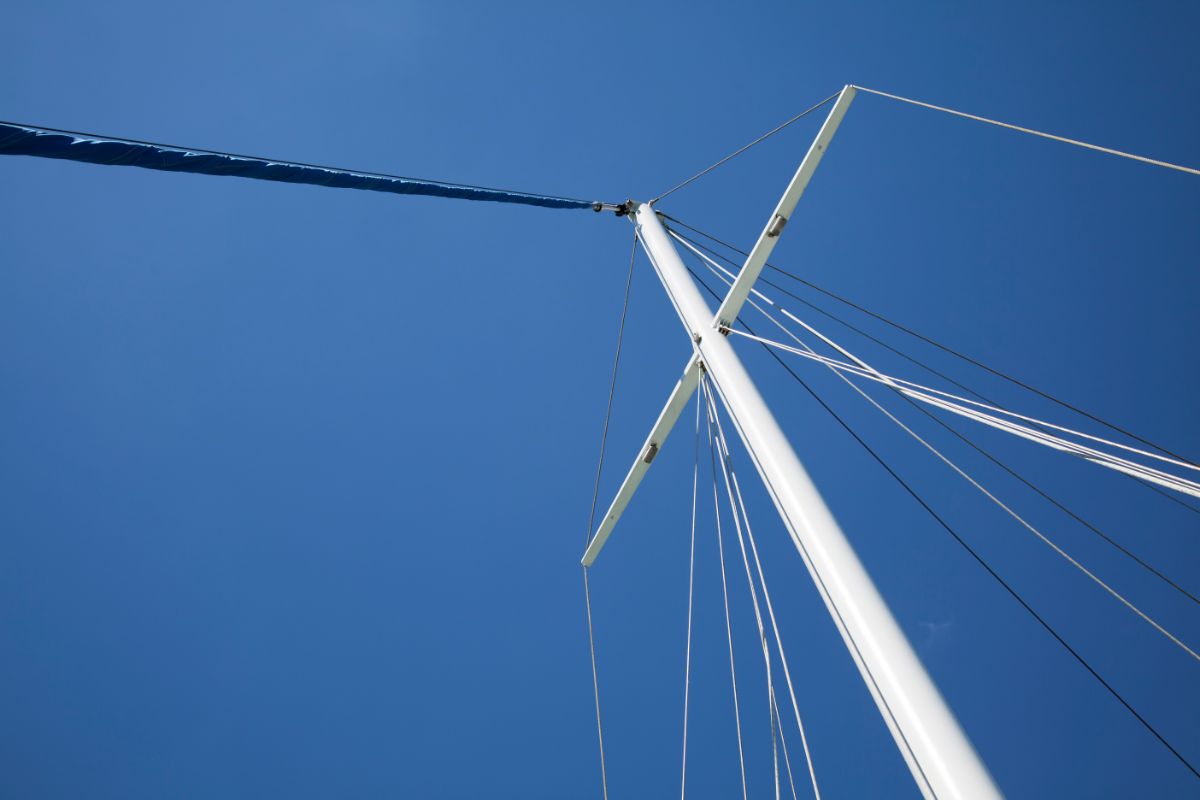
Mast Materials For Sailboats
The masts of sailboats (see also ‘ Two-Mast Sailboat Types ‘) are typically constructed of aluminum or other specific types of wood. Until the 1950s, almost all sailboat masts were constructed of wood.
That began changing around the time that fiberglass vessels rose to fame, with aluminum being now the most used mast material.
Aluminum Masts For Sailboats
Aluminum has become the most popular modern mast material. Aluminum masts are lighter in weight, hollow, and simple to produce. Such reasonably priced masts efficiently withstand seawater. These masts are also heavy for their size.
If there is one drawback to this type of mast that would be galvanic corrosion, which happens extremely quickly once seawater is in contact with aluminum and another metal, like steel and copper.
So, in types like the Bermuda-rigged sloop which are frequently made with aluminum, that is an issue.
Wooden Masts For Sailboats
The typical material for sailboat masts is wood, which is still employed for many specially designed boats nowadays.
Wood masts are big and bulky, yet very sturdy, and proper maintenance can guarantee their lengthy (over 100 years!) lifespan. They are also prevalent on gaff-rigged vessels because wood is best suited for short masts.
The Fir family provides the most popular mast wood. Although Douglas Fir is widely used, regional models (such as British, Columbian, and Yellow Fir) are also ideal.
Several sailboats, especially the tall ships, have masts made of pine and sometimes redwood. Other cedar species like the Port Orford or the Oregon cedar, can also be used for masts and spars.
Carbon Fiber Masts For Sailboats
Carbon fiber masts are a relatively new addition to the boatbuilding industry, and they have a few perks over the wood and aluminum ones.
First of all, carbon fiber is both strong and light, making it perfect for sailboats designed for races and which typically have tall masts. The best top-quality carbon fiber masts in the business are used by ships competing in America’s Cup races.
Maintenance Of Masts
It is critical to maintaining the sailboat masts and all of their associated hardware. Masts’ stays, lines, and halyards must be regularly checked, modified, and replaced on a regular basis. Masts made of wood must be lacquered and inspected for rot.
Masts made of aluminum do not typically require regular checks and maintenance, but any indications of a corrosive environment should be acted upon right away.
Build a clear maintenance schedule with your regional boat repairman or boating specialist. Keep in mind that preventative maintenance is always less expensive and simpler than repair work.
Choosing The Right Mast
For those who own a production boat, the options will be determined by the model and manufacturer.
The important factors to keep in mind for one-off boats without a designer sail plan are:
- the masts step’s features
- the length and displacement of the boat
- the addition of backstays and running backstays
- the quantity and placement of chainplates
If the mast is on a step on deck rather than on the structural beam, an image of the step may be useful to the mast maker.
For those who frequently take part in races, a carbon mast will save them from the extra weight and enhance their performance.
The Bottom Line
We hope that this article was helpful in learning more about a sailboat mast, the different types of mast you can see on vessels, as well as the materials they are made of, and their maintenance requirements.
Masts play a vital role in holding the boats in place, allowing people to keep on sailing to their dream destination, and they are also an eye-catching element of sailboats thanks to their vertical form and their length that often surpasses that of the sailboat itself.
Depending on the use of the boat, you will get a different type of mast, and the material it will be made of, its size, height, and weight, will guarantee the best sailing experience!
Related Posts:

- Mastering the Mast: A Comprehensive Dive into the World of Sailboat Masts and Their Importance
A mast is not just a tall structure on a sailboat; it's the backbone of the vessel, holding sails that catch the wind, driving the boat forward. Beyond function, it's a symbol of adventure, romance, and humanity's age-old relationship with the sea.
The Rich Tapestry of Sailboat Mast History
From the simple rafts of ancient civilizations to the majestic ships of the Renaissance and the agile sailboats of today, masts have undergone significant evolution.
- The Humble Beginnings : Early masts were basic structures, made from whatever wood was available. These rudimentary poles were designed to support basic sails that propelled the boat forward.
- The Age of Exploration : As ships grew in size and began journeying across oceans, the demands on masts increased. They needed to be taller, stronger, and able to support multiple sails.
- Modern Innovations : Today's masts are feats of engineering, designed for efficiency, speed, and durability.
A Deep Dive into Types of Boat Masts
There's no 'one size fits all' in the world of masts. Each type is designed with a specific purpose in mind.
- Keel Stepped Mast : This is the traditional choice, where the mast runs through the deck and extends into the keel. While providing excellent stability, its integration with the boat's structure makes replacements and repairs a task.
- Deck Stepped Mast : Gaining popularity in modern sailboats, these masts sit atop the deck. They might be perceived as less stable, but advancements in boat design have largely addressed these concerns.
Materials and Their Impact
The choice of material can profoundly affect the mast's weight, durability, and overall performance.
- Aluminum : Lightweight and resistant to rust, aluminum masts have become the industry standard for most recreational sailboats.
- Carbon Fiber : These masts are the sports cars of the sailing world. Lightweight and incredibly strong, they're often seen on racing boats and high-performance vessels.
- Wood : Wooden masts carry the romance of traditional sailing. They're heavier and require more maintenance but offer unparalleled aesthetics and a classic feel.
Anatomy of a Sail Mast
Understanding the various components can greatly improve your sailing experience.
- Masthead : Sitting atop the mast, it's a hub for various instruments like wind indicators and lights.
- Spreaders : These are essential for maintaining the mast's stability and optimizing the angle of the sails.
- Mast Steps and Their Critical Role : Climbing a mast, whether for repairs, adjustments, or simply the thrill, is made possible by these "rungs." Their design and placement are paramount for safety.
Deck vs. Yacht Masts
A common misconception is that all masts are the same. However, the requirements of a small deck boat versus a luxury yacht differ drastically.
- Yacht Masts : Designed for grandeur, these masts are equipped to handle multiple heavy sails, sophisticated rigging systems, and the weight and balance demands of a large vessel.
- Sailboat Masts : Engineered for agility, they prioritize speed, wind optimization, and quick adjustments.
Maintenance, Repairs, and the Importance of Both
Seawater, winds, and regular wear and tear can take their toll on your mast.
- Routine Maintenance : Regular checks for signs of corrosion, wear, or structural issues can prolong your mast's life. Using protective coatings and ensuring moving parts are well-lubricated is crucial.
- Common Repairs : Over time, parts like spreaders, stays, or even the mast steps might need repair or replacement. Regular inspections can spot potential problems before they escalate.
Read our top notch articles on topics such as sailing, sailing tips and destinations in our Magazine .
Check out our latest sailing content:
Costing: The Investment Behind the Mast
While the thrill of sailing might be priceless, maintaining the mast comes with its costs.
- Regular Upkeep : This is an ongoing expense, but think of it as insurance against larger, more costly repairs down the line.
- Repairs : Depending on severity and frequency, repair costs can stack up. It's always advisable to address issues promptly to avoid more significant expenses later.
- Complete Replacement : Whether due to extensive damage or just seeking an upgrade, replacing the mast is a significant investment. Consider factors like material, type, and labor when budgeting.
Upgrading Your Mast: Why and How
There comes a time when every sailor contemplates upgrading their mast. It might be for performance, compatibility with new sail types, or the allure of modern materials and technology.
- Performance Boosts : New masts can offer better aerodynamics, weight distribution, and responsiveness.
- Material Upgrades : Shifting from an old wooden mast to a modern aluminum or carbon fiber one can drastically change your sailing experience.
- Compatibility : Modern sails, especially those designed for racing or specific weather conditions, might necessitate a mast upgrade.
The Impact of Weather on Masts
Weather conditions significantly influence the longevity and performance of your mast. From strong winds to salty sea sprays, each element poses unique challenges. Regularly washing the mast, especially after sailing in saltwater, can help prevent the onset of corrosion and wear.
Customization and Personal Touches
Every sailor has a unique touch, and this extends to the mast. Whether it's intricate carvings on wooden masts, personalized masthead designs, or innovative rigging solutions, customization allows sailors to make their vessel truly their own.
The Role of Sails in Mast Design
It's not just about the mast; the type and size of sails greatly influence mast design. From the full-bellied spinnakers to the slender jibs, each sail requires specific support, tension, and angle, dictating the rigging and structure of the mast.
Safety First: The Role of Masts in Overboard Incidents
A mast isn't just for sailing; it plays a crucial role in safety. In overboard situations, the mast, especially when fitted with steps, can be a lifeline, allowing sailors to climb back onto their boat. Its visibility also aids in search and rescue operations.
The Rise of Eco-Friendly Masts
As the world grows more eco-conscious, the sailing community isn't far behind. New materials, designed to be environmentally friendly, are making their way into mast production. They aim to provide the strength and durability of traditional materials while reducing the environmental footprint.
The Intricate World of Rigging
The mast serves as the anchor for a complex system of ropes, pulleys, and cables – the rigging. This network, when fine-tuned, allows sailors to adjust sails for optimal wind capture, maneuverability, and speed. Mastery over rigging can elevate a sailor's experience and prowess significantly.
Historical Significance: Masts in Naval Warfare
In historical naval battles, the mast played a pivotal role. Damaging or destroying an enemy's mast was a strategic move, crippling their mobility and rendering them vulnerable. The evolution of masts in naval ships offers a fascinating glimpse into maritime warfare tactics of yesteryears.
The Science Behind Mast Vibrations
Ever noticed your mast humming or vibrating in strong winds? This phenomenon, known as aeolian vibration, arises from the interaction between wind and the mast's
structure. While it can be a mesmerizing sound, unchecked vibrations over time can lead to wear and potential damage.
Future Trends: What Lies Ahead for Sailboat Masts
With technological advancements, the future of masts is bright. Concepts like retractable masts, integrated solar panels, and smart sensors for real-time health monitoring of the mast are on the horizon. These innovations promise to redefine sailing in the years to come.
Paying Homage: Celebrating the Mast
Across cultures and ages, masts have been celebrated, revered, and even worshipped. From the Polynesians who viewed them as spiritual totems, to modern sailors tattooing mast symbols as badges of honor, the mast, in its silent grandeur, continues to inspire awe and respect.
Conclusion: The Mast’s Place in Sailing
In the grand scheme of sailing, the mast holds a place of reverence. It's not just a structural necessity; it's a testament to human ingenuity, our quest for exploration, and the sheer love of the sea.
How often should I inspect my mast?
At least twice a year, preferably before and after sailing season.
Can I handle repairs myself?
Minor repairs, yes. But for major issues, it's best to consult a professional.
Is there an average lifespan for a mast?
With proper care, masts can last decades. Material and maintenance quality play a huge role.
How do I know if it's time to replace my mast?
Constant repairs, visible wear, and decreased performance are indicators.
What's the most durable mast material?
Carbon fiber is incredibly strong and durable, but aluminum also offers excellent longevity.
So what are you waiting for? Take a look at our range of charter boats and head to some of our favourite sailing destinations.
Mast Queries Answered
I am ready to help you with booking a boat for your dream vacation. contact me..

Denisa Kliner Nguyenová

What is a Sailboat Mast?

A sailboat mast is the towering pole mounted to the deck. It attaches the length of the sail to the boat and supports the shape of the sail.
Sailboat masts are the most distinct feature of sailing vessels, and they hold the sails in place. Masts are often taller than the length of the boat. Most modern sailboat masts are made of aluminum, though traditional boats use wood. Sailboat mast type varies based on what type of sail plan they support.
Table of contents
Parts of the Mast
The mast itself is simply a pole and won't function without several essential parts. Starting from the deck is the mast boot, which keeps water from draining down the mast and into the cabin. The long wires connected to the mast on each side are the stays, and they keep the mast upright under tremendous force. The boom connects to the mast using a gooseneck fitting. Halyard lines, which run to the top of the mast, are used to raise and lower the sail.
Single-Mast Rigs
Single mast sailboats are what most people picture when they think of modern sailing craft. Single mast boats are popular because they're inexpensive to produce and relatively easy to operate singlehanded. The most common kinds of single-mast rigs are sloops, cutters, and catboats.
Sloop rig boats are the most common kind of sailboat today. Sloops feature a single mast mounted somewhere on the forward 3/5 of the deck, but some boat designs differ slightly. Generally speaking, a sloop mast lies somewhere in the middle to the forward-middle of the deck.
Sloop masts are rigged for a large mainsail and a jib. Bermuda-rigged sloops utilize a tall single mast and triangular sail. Gaff-rigged sloops, which are less common, use a much shorter mast and a larger four-point mainsail.
Catboat Mast
Catboats are unique vessels common to New England and feature a forward-mounted single mast and a long boom. Unlike sloop-rigged boats, catboats are only rigged for a single sail. Catboat masts are generally mounted almost at the very front of the boat, and they're often short and quite thick.
Catboats are almost often gaff-rigged. Gaff-rigged sail plans make the most of short masts and are relatively easy to control in a single-mast configuration. Gaff-rigged catboat masts are shorter than Bermuda-rigged boats of similar size but generally taller than similar gaff-rigged craft.
Cutter Mast
Cutter-rigged sailboats feature a tall single mast and multiple headsails. Visually, cutters are easy to mistake for sloops. But the mast of a cutter is usually taller than a comparably-sized sloop, as it utilizes multiple headsails instead of a single jib.
Gaff-rigged cutters are much more common than gaff-rigged sloops in many areas. Cutters are easy to distinguish from sloops, even when the sails are stowed. This is because cutters often feature a long bowsprit and two front stays (forestay and jib stay).
Multi-Mast Rigs
Mult-mast rigs are less common than single-mast configurations. That said, multi-mast sailboats are often elegant and seaworthy. Though they offer more than just good looks—multiple masts offer speed and precise control for experienced sailors. Most of these vessels feature two masts, which are often shorter than masts on comparably-sized single-mast craft. The most common variations are yawl rigs, ketch rigs, and schooner rigs.
Yawls are robust multi-mast vessels that vary in length from 20 feet to well over 50 feet. A yawl features a long forward mainmast and a short mizzen mast located towards the back of the boat. Yawls are often gaff-rigged and were once used as utility boats.
Yawl rigged sailboats can use the mizzen mast and sail as a form of self-steering. The yawl is easy to distinguish from other two-masted vessels, as the mizzenmast is comparably short—often about half the size of the mainmast. Additionally, the mizzen mast is positioned aft of the rudder post.
Ketch Masts
At first glance, a ketch can be mistaken for a yawl. But the ketch features two similarly-sized masts and a much larger mizzen. The mizzen mast on a ketch is positioned forward of the rudder post. Ketch-rigged boats are often gaff-rigged as well, utilizing topsails on both masts. Some ketch-rigged boats have triangular sailplanes, mitigating the need for topsails.
Like the yawl, the ketch utilizes a headsail, a mainsail , and a mizzen sail, which is comparable in size to the mainsail. Ketch-rigged boats can be sailed with one or more aft sails stowed.
Schooner Masts
Schooners are among the most elegant multi-mast sailboat types. Schooners are visibly closer to ketches than yawls. But upon closer inspection, a schooner will have a shorter foremast and a longer (or almost equally-sized) mast behind it.
Schooner masts are tall and thick but usually shorter than similarly-sized single mast boats. This is because two-masted vessels distribute the sail plan over two masts and don't need the extra length to make up for lost sail area. Schooners are usually gaff-rigged and often utilize topsails and topmasts that extend the height of the mast.
Tall Ship Masts
Tall ships are the classic large sailing vessels that dominated the oceans for hundreds of years before the age of steam. Famous vessels such as the U.S.S. Constitution and the H.M.S. Victory feature this enormous and complex rig configuration.
Tall ships have three or more enormous masts, which are often made from entire tree trunks. Some of the largest tall ships have five or more masts. Tall ships are usually 100 feet in length or greater, as the size and complexity of these square-rigged ships make them only practical at scale. Tall ships utilize one or more mainmasts, mizzenmasts, a foremast, and a gaff-rigged jigger mast aft of the mizzenmast.
Sailboat Mast Materials
Sailboat masts are usually made out of aluminum or certain varieties of wood. Up to the 1950s, virtually all sailboat masts were made of wood. That changed around the same time that fiberglass boats became popular. Today, aluminum is the most common mast material.
Aluminum Sailboat Masts
The most common modern mast material is aluminum. Aluminum masts are lightweight, hollow, and easy to manufacture. These relatively inexpensive masts hold up well to salt water. Aluminum masts are also strong for their weight.
One downside to aluminum masts is galvanic corrosion, which occurs frightfully fast when saltwater comes into contact with aluminum and another metal (such as steel or copper). Aluminum masts are most common on Bermuda-rigged sloops.
Wood Sailboat Masts
Wood is the traditional material for sailboat masts, and it's still used today on many custom boats. Wood masts are heavy but strong, and a well-maintained wood mast can last over a hundred years. Wooden masts are common on gaff-rigged boats, as wood is an ideal material for shorter masts.
The most common mast wood comes from the Fir family. Douglas fir is common, but regional varieties (such as British, Columbian, and Yellow fir) are perfectly suitable. Some sailboats (particularly tall ships) use pine or redwood as a mast material. Some varieties of cedar (such as Port Orford cedar, Oregon cedar, and white cedar) are also excellent materials for building masts and spars.
Carbon Fiber Masts
Carbon fiber masts are a new arrival to boatbuilding, and they offer some advantages to wood and aluminum masts. Carbon fiber is lightweight and extremely strong, which makes it ideal for tall-masted racing sailboats. Vessels that compete in America's Cup races utilize the most premium carbon fiber masts in the industry.
Unlike wood (and aluminum to some extent), carbon fiber masts aren't particularly flexible. The rigidity of carbon fiber makes it strong, but stiffness is also a weakness. Under the right conditions, carbon fiber masts can break violently and are impossible to repair once broken.
Mast Maintenance
It's essential to maintain your mast and all of its accompanying hardware. Mast stays, lines, and halyards should be inspected regularly, adjusted, and replaced at regular intervals. Wooden masts should be varnished and checked for signs of rot.
Aluminum masts are generally low-maintenance, but signs of corrosion warrant immediate repair. Work with your local boat mechanic or sailing expert to develop a comprehensive maintenance plan. And remember, preventative maintenance is always cheaper and easier than repairs.
Related Articles
Daniel Wade
I've personally had thousands of questions about sailing and sailboats over the years. As I learn and experience sailing, and the community, I share the answers that work and make sense to me, here on Life of Sailing.
by this author
Sailboat Parts
Learn About Sailboats
Most Recent

What Does "Sailing By The Lee" Mean?
October 3, 2023

The Best Sailing Schools And Programs: Reviews & Ratings
September 26, 2023
Important Legal Info
Lifeofsailing.com is a participant in the Amazon Services LLC Associates Program, an affiliate advertising program designed to provide a means for sites to earn advertising fees by advertising and linking to Amazon. This site also participates in other affiliate programs and is compensated for referring traffic and business to these companies.
Similar Posts

Affordable Sailboats You Can Build at Home
September 13, 2023

Best Small Sailboat Ornaments
September 12, 2023

Discover the Magic of Hydrofoil Sailboats
December 11, 2023
Popular Posts

Best Liveaboard Catamaran Sailboats
December 28, 2023

Can a Novice Sail Around the World?
Elizabeth O'Malley
June 15, 2022

4 Best Electric Outboard Motors

How Long Did It Take The Vikings To Sail To England?

10 Best Sailboat Brands (And Why)
December 20, 2023

7 Best Places To Liveaboard A Sailboat
Get the best sailing content.
Top Rated Posts
© 2024 Life of Sailing Email: [email protected] Address: 11816 Inwood Rd #3024 Dallas, TX 75244 Disclaimer Privacy Policy
- Destination Information
- Sailing routes
- Boat owners
- Tips & Inspiration
- Sustainable Sailing

- Featured Posts: The Latest News
- Nautical Knowledge
What a sailboat mast? All you need to know!
- 8 August 2023
- 4 minute read
Alice Martin

Share the post "What a sailboat mast? All you need to know!"
If you are an avid sailor, you will understand the importance knowing about the different parts of a sailboat. There are few things as fundamental as the sailboat mast. Rising tall from the deck, the mast is an important structure that harmonises the wind and water to propel the vessel forward. In this blog post, we will explore the different components of a sailboat mast and dive into the fascinating world of single mast rigs and multi-mast rigs, each offering a unique sailing experience.
At Click&Boat, we like to keep you up to date with all things sailing. Read on to find out more about the different parts and uses of the mighty sailboat mast!
What is a sailboat mast?
At its core, a sailboat mast is a vertical pole that extends upward from the deck of the boat. It plays an important role in supporting the sails and maintaining their shape to maximise the use of wind. The material used to make sailboat masts is typically aluminum, carbon fiber, or wood, with each material offering its own unique benefits.
What are the different parts of a sailboat mast?
A sailboat mast consists of several integral parts:
Base and Step: The mast is securely fixed to the boat’s deck using a base and step, which provide stability and distribute the forces exerted by the sails.
Masthead: Located at the very top of the mast, the masthead is an attachment point for various rigging elements, such as halyards and stays.
Spreaders: These are horizontal bars extending from the mast, which help to keep the shrouds (supporting cables) away from the mast, providing better support for the rig.
Boom: The boom is a horizontal spar that extends from the bottom of the mast, holding the foot of the mainsail and controlling its angle.
Now that we have an overview of the sailboat mast let’s delve into the two primary types of sailboat rigs: single-mast rigs and multi-mast rigs.
Single – mast rigs
There are 3 different types of single mast rigs: Sloop – Rigged Mast, Cutter Mast and Catboat Mast.
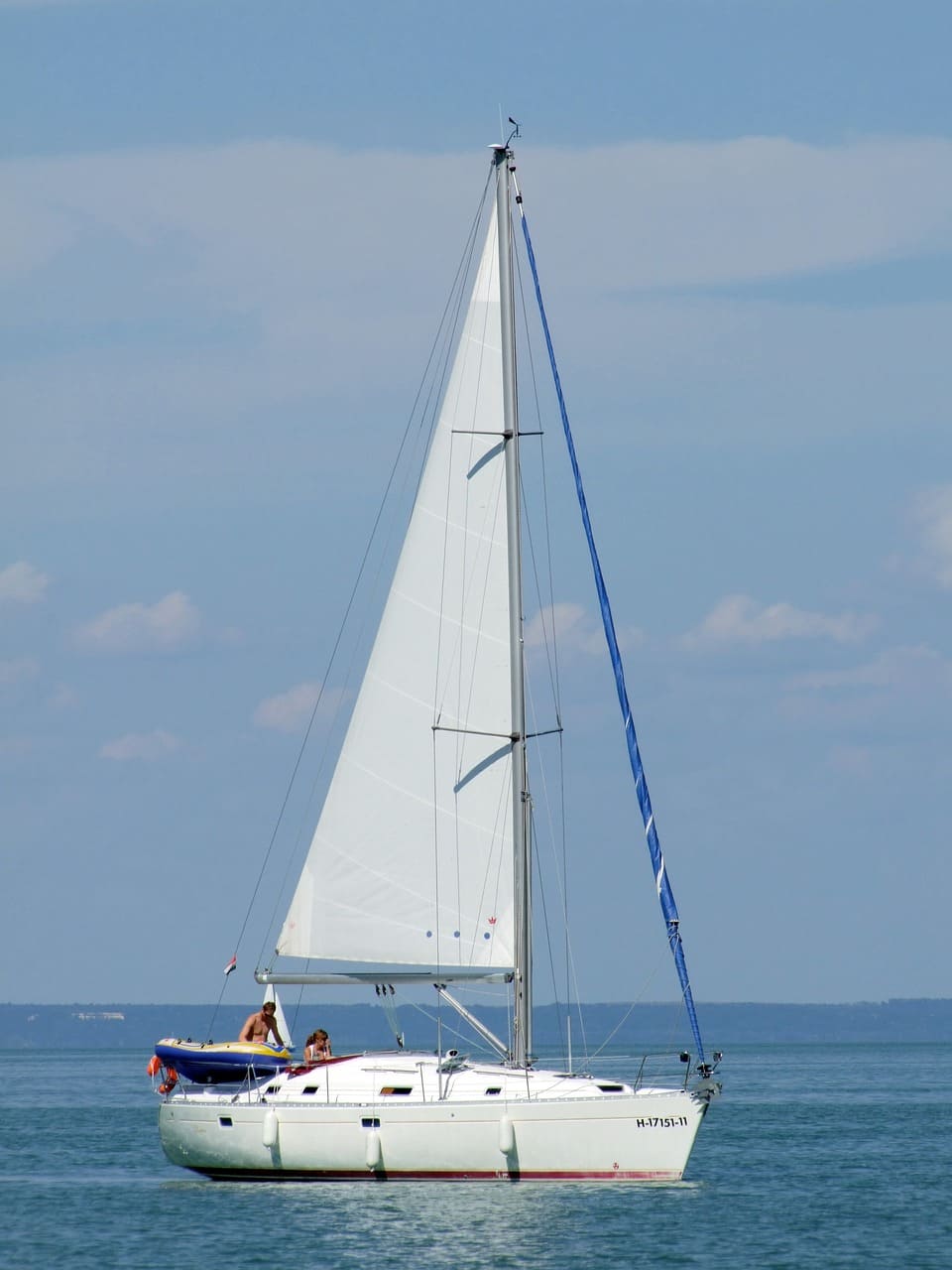
Sloop – Rigged Mast
The sloop rig is one of the most common and simple configurations for a single mast sailboat. It features a single mast with two sails – a mainsail and a foresail (jib or genoa). Attached to the boom is the mainsail. The foresail secures to the forestay at the bow and a headsail furler, allowing for easy reefing and unfurling.
Cutter Mast
The cutter rig is a variation of the sloop rig, with an additional smaller headsail, known as the staysail. This configuration provides more sail area options, offering increased versatility and better performance in varying wind conditions. The staysail is set between the forestay and an inner forestay, creating a more balanced sail plan.
Catboat Mast
The catboat rig is a unique single mast configuration that features a single, large mainsail with no headsail. This makes it easy to handle, especially for beginners. The lack of a headsail makes the catboat less efficient for upwind sailing but ideal for downwind and reaching courses.
Multi – Mast rig
There are 3 different types of Multi – Mast rigs: Yawl Masts, Ketch Masts, and Schooner Masts.

The yawl rig has two masts – a taller main mast and also a shorter mizzen mast, located forward of the rudder post. The mizzen mast helps improve balance and control, making it easier to handle in rough seas. The yawl rig allows for a diverse range of sail combinations, enhancing the sailboat’s adaptability.
Ketch Masts
The ketch rig features two masts, but with the mizzen mast positioned aft of the rudder post. This configuration offers better downwind performance and maneuverability while sacrificing some upwind efficiency. Ketch rigs are popular for long-distance cruising vessels due to their versatility.
Schooner Masts
The schooner rig has two masts, with the forward mast (foremast) being taller than the aft mast (mainmast). Schooners often feature multiple foresails and square topsails on their masts, providing an extensive sail area for excellent downwind performance.
For any sailor, understanding the sailboat mast and its various configurations is essential for navigating the waters with confidence. The sailboat mast stands as an excellent example of engineering. It symbolizes the very essence of sailing – the harmonious dance between the wind, water, and the spirit of adventure. next time you set sail, take a moment to appreciate the sailboat mast. the sturdy backbone that carries you on your nautical journey. Happy sailing!
- Inspiration
Sunset Sailing: The Complete Handbook
- 31 July 2023
- Clara Chambers

Boating activities for your next adventure
- 10 August 2023
You May Also Like
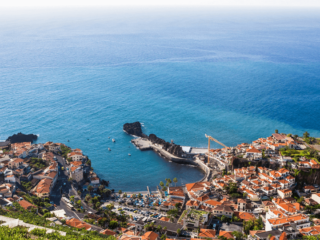
Discovering Madeira: boat trip ideas to explore the island
- 7 September 2024

Your City Break Holidays to Barcelona During the America’s Cup
- 21 August 2024

What you need to know for a boat safety certificate in the United States
- 7 July 2024
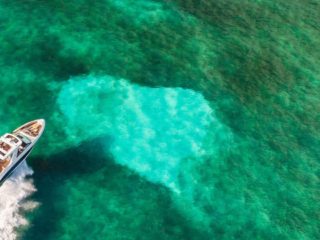
Budgeting for your daily boat hire
- 6 July 2024

For your next motorboat trip: A skippered or a bareboat charter?
- 3 July 2024

What to bring aboard a motorboat: your boating checklist
- 1 July 2024

First time renting with Click&Boat? Here’s What You Need to Know!
- 30 June 2024

- About Click&Boat
Click&Boat’s guide to using a boat licence abroad
- 29 June 2024
Leave a Reply Cancel reply
Your email address will not be published. Required fields are marked *
Save my name, email, and website in this browser for the next time I comment.
This site uses Akismet to reduce spam. Learn how your comment data is processed .
Input your search keywords and press Enter.

What Is A Sailboat Mast?
A sailboat mast is one of the most defining features of a sailboat (along with the sails of course!) You can immediately tell that a boat is a sailing boat when you spot the tall mast sticking out of the hull.
But why do sailboats need a mast? Having lived on a sailboat for years now I’ve never really questioned the need for a mast. It’s such an integral part of the boat that I just sort of forget it’s there!
When our friends recently lost their mast due to a rigging failure it got me thinking – why do sailboats need a mast and what function (aside from holding up the sails) do they actually play. It turns out, quite a lot!
We’re going to dive into the fascinating world of sailboat masts, exploring different rigs, mast materials, and the different functions that masts play. It’s important stuff if you want to go sailing, and a lot of it I should have known sooner!

As an Amazon Associate, we earn from qualifying purchases. We also earn from other affiliate programs. This means we may receive a small commission on products purchased through our links at no extra cost to you.
Table of Contents
Why do sailboats need a mast, parts of the mast, what materials are masts made from, single mast rigs, sailboats with two masts, sailboats with three masts, how to look after your mast.

A sailboat mast is a vertical, upright structure that supports the sails of a sailboat. It is a crucial component of the boat’s rigging system and plays a key role in harnessing the power of the wind to propel the vessel. Typically located in the center of the boat, the mast extends upward from the deck or hull.
The height of the mast varies depending on the size and type of the sailboat, directly impacting the sail area and overall performance of the boat.
Together with the boom (a horizontal spar attached to the bottom of the mast), the mast allows sailors to control the shape and orientation of the sails, optimizing their efficiency in different wind conditions.
The design and configuration of the mast can vary depending on the type of sailboat, such as a sloop, cutter, ketch, or schooner.
Sailboats require a mast primarily to support the sails.
It holds the sails in an elevated position, allowing them to catch the wind effectively. Without a mast, the sails would lack the means to be raised and positioned to harness the power of the wind.
There are a few other important jobs that the mast plays:
Control and Manipulation of Sails: The mast, along with the boom (a horizontal spar attached to the mast’s lower end), enables sailors to control and manipulate the sails.
By adjusting the angle and tension of the sails through the mast, sailors can optimize their performance according to wind conditions and desired boat speed.
This control allows for maneuverability and efficient use of wind power.
Structural Integrity: The mast contributes to the overall structural integrity of the sailboat. It helps distribute the loads and forces exerted by the sails, rigging, and masthead components throughout the boat’s hull and keel.
The mast’s design and construction ensure stability and strength, allowing the boat to withstand the forces generated by the wind.
Attachment Points for Rigging: The mast provides attachment points for various rigging components, including halyards (lines used to raise and lower the sails), stays (wires or rods that support the mast in different directions), and shrouds (wires that provide lateral support to the mast).
These rigging elements are essential for properly tensioning the sails and maintaining the mast’s stability.
Height and Visibility: The mast’s height contributes to the sailboat’s visibility, allowing other vessels to spot it more easily, particularly when sailing in congested waters. The mast’s presence also serves as a visual reference for determining the boat’s position, orientation, and distance from potential hazards.
While the mast’s primary purpose is to support the sails and enable control over their position, it also plays a significant role in maintaining the structural integrity of the sailboat and enhancing its visibility on the water.
Basically, the mast is pretty darn important!

Along with a million other confusing sailboat terms , the mast has lots of different parts too. A sailboat mast consists of several distinct parts, each serving a specific function. Here are the different parts commonly found on a sailboat mast:
- Masthead: The masthead is the topmost section of the mast. It often includes attachment points for various components such as halyards (lines used to raise and lower the sails), the forestay (the wire or rod that supports the front of the mast), and other rigging elements. The masthead may also house instruments like wind vanes or antennas.
- Spreaders: Spreaders are horizontal bars attached to the mast, typically positioned at specific intervals along its length. They help support the rigging wires and prevent excessive sideways bending of the mast. The position and angle of the spreaders contribute to the proper alignment and tension of the rigging.
- Shrouds: Shrouds are the wires or cables that provide lateral support to the mast. They connect the mast to the sides of the boat, helping to stabilize the mast and distribute the loads generated by the sails. Shrouds are typically tensioned using turnbuckles or other adjustable fittings.
- Backstay: The backstay is a cable or wire that provides support to the rear of the mast. It helps counterbalance the forces exerted by the forestay and the mainsail, preventing the mast from excessively bending forward. Adjustable backstays allow for tuning the mast’s rigidity based on wind conditions and sail trim.
- Halyard Sheaves: Halyard sheaves are small wheels or pulleys located at the masthead or lower down the mast. They guide halyards, which are lines used to raise and lower the sails. Halyard sheaves minimize friction, allowing smooth and efficient hoisting or lowering of the sails.
- Gooseneck: The gooseneck is a fitting that connects the boom to the mast. It allows the boom to pivot or rotate horizontally, enabling control over the angle and position of the mainsail. The gooseneck may include a pin or other locking mechanism to secure the boom to the mast.
- Mast Step: The mast step is the base or fitting where the mast rests and is secured to the deck or hull of the sailboat. It provides stability and distributes the loads from the mast to the boat’s structure.
These are some of the primary parts found on a sailboat mast. The specific configuration and additional components may vary depending on the sailboat’s design, rigging system, and intended use.

I was surprised to learn that sailboat masts are commonly made from several different materials, each offering its own advantages in terms of strength, weight, and flexibility.
The choice of material depends on various factors, including the type and size of the sailboat, desired performance characteristics, and budget.
Here are some of the materials used for sailboat mast construction:
Aluminum is a popular choice for sailboat masts due to its favorable combination of strength, lightweight, and corrosion resistance. Aluminum masts are relatively easy to manufacture, making them cost-effective. They offer good stiffness, enabling efficient power transfer from the sails to the boat.
Carbon Fiber
Carbon fiber has gained significant popularity in sailboat mast construction, especially in high-performance and racing sailboats. You’ll see black carbon fibre masts on fancy sailboats!
Carbon fiber masts are exceptionally lightweight, providing excellent stiffness-to-weight ratios. This allows for enhanced responsiveness, improved performance, and reduced heeling (tilting) of the boat.
Carbon fiber masts can be precisely engineered to optimize flex patterns and provide targeted strength where needed.
Traditional sailboats, particularly those with a classic or vintage design, may have masts made from wood. Wood offers an aesthetically pleasing and traditional look.
Wooden masts can be constructed using solid wood or laminated techniques, which involve layering thin strips of wood for added strength and stability. Wood masts require regular maintenance, including varnishing and sealing to protect against moisture.
In some cases, steel may be used for sailboat masts, especially in larger vessels or those designed for specific purposes, such as offshore cruising or heavy-duty applications.
Steel masts offer robustness and durability, but they are heavier compared to other materials. They require adequate corrosion protection to prevent rusting.
Composite Materials
Sailboat masts can also be constructed using composite materials, such as fiberglass or fiberglass-reinforced plastics. These materials provide a balance between cost, weight, and strength. Fiberglass masts can be an option for recreational sailboats or those on a tighter budget.
It’s worth noting that advancements in materials and manufacturing techniques continually evolve, introducing new possibilities for sailboat mast construction.
The choice of mast material should consider factors such as boat type, intended use, performance requirements, and personal preferences, balanced with considerations of cost and maintenance.
Different Types Of Masts

There are several different types of masts used in sailboat designs, each with its own characteristics and purposes.
We’ve included how the masts are fixed on the boat. This one is an important one when buying a sailboat as you might have a preference over how your mast is attached to the hull or deck.
We’ve also included different rigs, as some boats have just a single mast and other sailboats will have two or more masts. Again, you might have a preference as to which rig set up you prefer so it’s worth knowing the pros and cons of each.
Keel-stepped Mast
A keel-stepped mast is one that extends down through the deck and is secured to the boat’s keel or structural framework. Keel-stepped masts offer stability and strength, as they transfer the loads directly to the boat’s foundation.
They are commonly found in larger sailboats and offshore cruising vessels. We loved knowing our deck was secured to one of the strongest parts of the boat.
It does come with some problems though, like the fact it can leak and start raining in the boat! A decent mast boot will stop this.
Deck-stepped Mast
A deck-stepped mast rests on a step or fitting on the deck, rather than extending down through it. Deck-stepped masts are typically used in smaller sailboats and are more straightforward to install, maintain, and unstep.
They are often lighter and less expensive than keel-stepped masts but may sacrifice some stability and rigidity.
Fractional Rig
A fractional rig features a mast where the forestay is attached below the masthead, typically at a point less than halfway up the mast’s height. This design allows for a larger headsail and a smaller mainsail.
Fractional rigs are popular on modern cruising and racing sailboats as they offer versatility, easy sail control, and improved performance in various wind conditions.
Masthead Rig
In a masthead rig, the forestay attaches at the top of the masthead. This design is commonly found in traditional sailboats. Masthead rigs typically feature larger headsails and smaller mainsails. They are known for their simplicity, easy balance, and suitability for cruising and downwind sailing.
There are various different rig set ups that just have one single mast. We’ll look at a few of the most popular types, but be aware that there are quite a few variations out there these days! It can get a little complicated!
The sloop rig is one of the most popular and widely used single mast rigs. It consists of a single mast with a mainsail and a headsail. The headsail, typically a jib or genoa, is attached to the forestay at the bow of the boat, while the mainsail is attached to the mast and boom.
Sloops offer simplicity, versatility, and ease of handling, making them suitable for a wide range of sailboats, from small day-sailers to larger cruising vessels.
A cutter rig utilizes two jibs : a smaller headsail attached to the forestay and a larger headsail called a staysail attached to an inner stay or a removable stay.
The mainsail is usually smaller in a cutter rig. This rig provides versatility and options for different sail combinations, making it suitable for offshore cruising and handling various wind conditions.
We absolutely loved our cutter rig as it gave so much flexibility, especially in heavy weather. A downside is that tacking is a little harder, as you have to pull the genoa past the stay sail.
Sailboats with two masts tend to be seen on older boats, but they are still popular and quite common, especially with long-distance sailors looking for versatility.
The yawl rig features two masts, with a shorter mizzen mast positioned aft of the main mast and rudder stock. The mizzen mast is usually shorter than the main mast.
Yawls offer versatility, improved balance, and increased maneuverability, making them suitable for offshore cruising and long-distance sailing.
A ketch rig has two masts: a taller main mast located near the boat’s center and a shorter mizzen mast positioned aft of the main mast but forward of the rudder stock. The mizzen mast is typically shorter than the main mast.
Ketch rigs provide additional sail area and options for sail combinations, offering good balance and flexibility for cruising and long-distance sailing. A lot of long-term cruisers love ketch rigs, though they tend to be found on older boats.
The downside is that you’ll have two masts with accompanying rigging to maintain, which isn’t necessarily a small job.
Sailboats with three masts or more are rare. They tend to be seen only on very large, expensive sailing yachts due to the additional expense of maintaining three masts, rigging and additional sails.
They aren’t great for single-handed crews but they do look very impressive and can power bigger vessels.
Schooner Rig
A schooner rig features two or more masts, with the aft mast (known as the mizzen mast) being taller than the forward mast(s).
Schooners are known for their multiple headsails and often have a gaff-rigged or square-rigged configuration on one or both masts. Schooner rigs offer impressive sail area, versatility, and classic aesthetics.
Schooner rigs are much rarer than the rigs mentioned above so it’s unlikely you’ll find one on a cruising vessel.
These are just a few examples of the different types of masts used in sailboat designs. Each rig type has its own advantages and considerations in terms of sail control, performance, balance, and intended use.
The choice of mast and rig depends on factors such as boat size, purpose, sailing conditions, and personal preferences.

We didn’t know the first thing about looking after our mast when we first moved aboard and we made it our mission to find out. When you’re sailing frequently then the last thing you want is to experience a mast coming down mid-passage!
Taking proper care of your sailboat mast is important to ensure its longevity and optimal performance. Here are some tips on how to look after your mast:
- Regular Inspections: Conduct regular visual inspections of your mast to check for any signs of damage, wear, or corrosion. Look for cracks, dents, loose fittings, or any other issues that may compromise the mast’s integrity.
- Cleaning: Keep your mast clean by regularly washing it with fresh water. Remove dirt, salt, and other contaminants that can accelerate corrosion. Use a mild detergent or boat-specific cleaner, and rinse thoroughly.
- Corrosion Prevention: Protect your mast from corrosion by applying a suitable corrosion inhibitor or protective coating. Pay particular attention to areas where fittings, rigging, or other components come into contact with the mast.
- Lubrication: Lubricate moving parts such as sheaves, shackles, and slides with a marine-grade lubricant. This helps prevent friction and ensures smooth operation. Be cautious not to over-lubricate, as excess lubricant can attract dirt and debris.
- Rigging Maintenance: Inspect your rigging regularly for signs of wear, such as broken strands, fraying, or excessive stretching. Replace any worn or damaged rigging promptly to avoid potential mast damage.
- UV Protection: The sun’s UV rays can degrade and weaken the mast over time. Protect your mast from UV damage by applying a UV-resistant coating or using mast covers when the boat is not in use.
- Storage Considerations: If you need to store your boat for an extended period, consider removing the mast and storing it horizontally or in a mast-up position, depending on the boat design. Store the mast in a clean, dry, and well-ventilated area to prevent moisture buildup and potential damage.
- Professional Inspections: Periodically have your mast inspected by a professional rigger or boatyard to assess its condition and identify any potential issues that may require attention. They can provide expert advice on maintenance and repair.
Remember, if you are unsure about any maintenance or repair tasks, it’s always recommended to consult with a professional rigger or boatyard to ensure proper care and safety of your mast.
We learned so much from having our rigging inspected, so we highly recommend you do this if you’re at all unsure.
Conclusion: What Is A Sailboat Mast?
In conclusion, a sailboat mast is a crucial component that plays a vital role in the performance, control, and integrity of a sailboat. It’s a good idea to learn about sailboats before you head out on a sail – unlike us!
The mast serves as a vertical structure that supports the sails, allowing them to capture the power of the wind effectively. The mast enables sailors to control and manipulate the position of the sails, optimizing performance based on wind conditions.
Additionally, the mast contributes to the overall structural integrity of the boat, distributing loads and forces throughout the hull and keel. Various rigging components, such as halyards, shrouds, and spreaders, are attached to the mast, providing support and enabling precise sail control.
By understanding the importance of the mast and properly caring for it through regular inspections, cleaning, corrosion prevention, lubrication, and rigging maintenance, sailors can ensure their mast’s longevity and optimal performance.
A well-maintained sailboat mast contributes to a safe, enjoyable, and successful sailing experience.
- How much do new sails cost?
- How long do new sails last?
- Storm sails
Similar Posts

What Is The Jib Sail On A Sailboat?

Can You Live On A Boat On Land And What’s It Really Like?

Sailboat Keel Types: Pros And Cons 2024

11 Tips For Crossing The Atlantic By Sailboat 2024

Sailing With A Baby: Essential Guide 2024

The Best Hot Chocolate Recipe For Sailing!
Browse by Category
- Coach of the Year
- High School Sailing Team of the Year
- Optimist Sailor of the Year
- Sailing Fitness
- Regatta News/Results
- Boat Speed/Tuning/Sailtrim Articles
- General Sailing News
- Coaches Locker Room
- From the Experts
- Profiles in Pro Sailing
- Featured Jobs
- Marketplace Ads
- Skip to primary navigation
- Skip to main content
- Skip to primary sidebar
- Skip to footer
Sail1Design
First Name*
Email Address*
The Aluminium Cocktail: What Goes Into The Perfect Mast
November 8, 2016 by Sail1Design Editor 1 Comment
By Mark Jardine of Yachts & Yachting While carbon is the ‘sexy’ material of choice for spars, aluminium accounts for a far greater proportion of the masts and booms used in sailing and is much cheaper. What goes into an aluminium mast, and the processes to consistently produce a good spar, though are far from simple – like a good cocktail, the mix of ingredients and the production processes are vital. We spoke to Selden’s Steve Norbury and Andy McCormack to find out more… Firstly we talked to Steve about aluminium itself and where masts sit in the different ‘series’ available to a manufacturer. “Over time masts have been made from quite a different number of series of aluminium, all to have different properties. The series of aluminium that is mostly used for mast manufacture, and what we use is 6000 series. The 6000 is relatively hard, extrudes well, is heat treatable and has good corrosion resistance. This means that we can buy them in a soft condition so that we can work with them, and then heat treatment brings them up to full strength. So overall, 6000 series aluminium is reckoned to be the best to make dinghy and yacht spars from. “There are other families; the 2000 series is a copper-based aluminium and is also very strong. You would think they would make ideal masts, but unfortunately, they have terrible corrosion resistance. If you stored your mast in a bag, maybe for the Winter, you would literally open up that bag in the Spring and find that you had a pile of white powder! “Another series which is used, is 7000 series. 7000 series has the advantage over the 6000 series in that its yield point is high. That means it is a very strong metal that you can bend further without it taking a permanent set. The disadvantage is that it is almost impossible to work with. You can buy 7000 series round tube, but you can’t get profile section, you can’t taper it, you can’t weld it, and again it has a corrosion problem in that after a few years you would find that your fittings start corroding. So it has been used for windsurfing masts and used for some Optimist spars, but, generally for dinghy spars 6000 is the best material that you can use.”
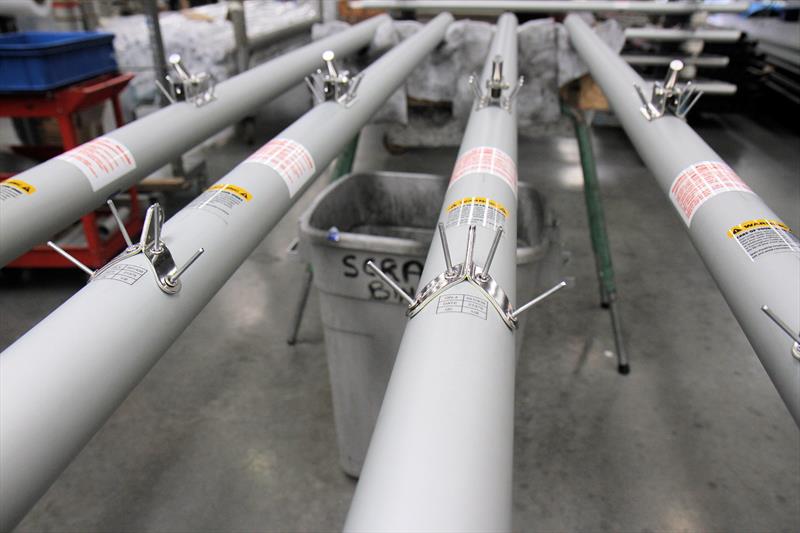
Andy McCormack is Technical Director at Selden and we asked him how you go about extruding a mast into a particular section. “We have a range of sections, seven or eight, covering the entire dinghy range; some of them are very close together. Cumulus is our most popular section, we also have another section called Alto which is very slightly stiffer, and one called Zeta, which is slightly more flexible – they are very, very close together. Due to the volume of aluminium that we buy, we are able to have three separate dies, that are discrete sections, but very, very close, just a few percent stiffer or more flexible each way.”
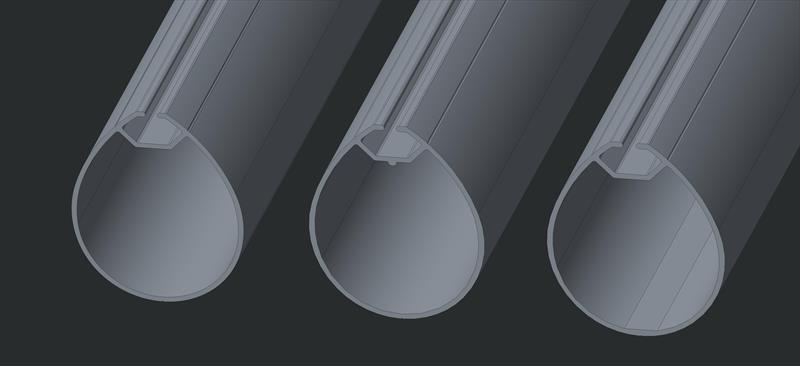
With this range of sections, and having masts that are very similar in their characteristics, we wanted to know how they could ensure repeatability, managing to produce the same mast each time. Andy explains: “Due to the volume of aluminium extrusions that we buy, we have a tighter set of tolerances that we have agreed with our supplier. Rather than using a British Standard or ISO Standard, we have a Selden Spar standard, which governs overall dimensions, wall thickness, straightness, material properties, and this standard is much tighter than commercially agreed standards that other people may use.” The next problem for repeatability is when a mast section is tapered. This requires a cut and weld in a spar and we wanted to know how they kept the same mast characteristics each time. Andy told us about the technology Selden use to improve consistency: “Rather than cutting the taper by hand, we have a plasma cutting machine, essentially a CNC machine, cutting a section out of the top of the mast, very accurately and consistently.

“We then press that together on a custom tooling for each section. After that the taper is welded on an auto welder – again, this is the same every time. This results in very tight tolerances and is completely repeatable; there is no human intervention.
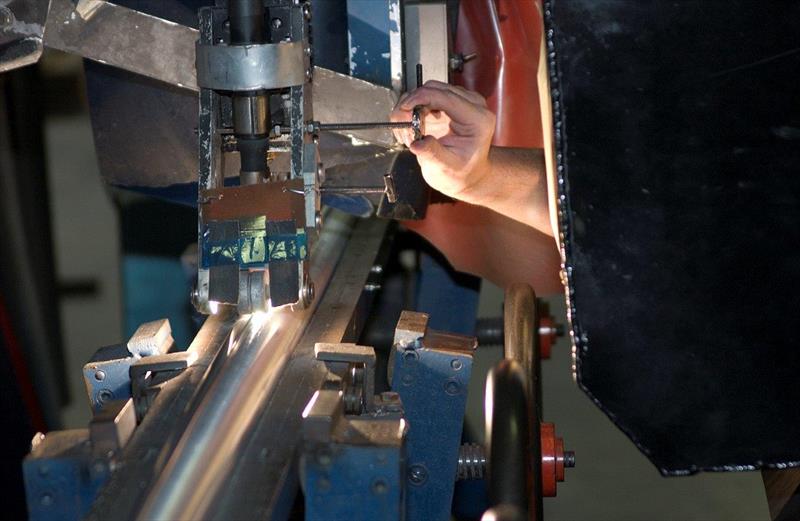
The final stage of creating a mast is having it heat-treated and then anodized. Andy explains how Selden go about this process: “We have our own heat treatment oven that is computer controlled with sensors clipped to mast tubes. This produces a graph of the heat cycle for every run. This way we can be certain that the material in the oven has been correctly heat treated. We carry out a peening operation which gives us a uniform surface finish, it also removes any impurities off the surface of the material. That allows us to send it for anodizing in a state where they have to do the absolute minimum of cleaning and etching, meaning there is no further reduction in material before the anodizing is put on.”

Like all industries and companies, aluminium spar making is moving on, and Selden are at the forefront of experimentation and innovation. We asked Steve what changes are in the pipeline: “We are all always working with our extruder to develop new modifications to this, or new blends if you like. We are working on some material now, which gives us a much higher yield point – for a dinghy sailor means that a mast will bend further before taking a permanent set. So while we are trying to improve that, we are also trying to retain its surface finish and its anodizing properties.” Finally we wanted to dispel some myths about aluminium masts, particularly with regard to bend and gust response. Steve explained the facts to us: “Gust response is all about when a gust hits, the masts bends, and when the gust disappears, the mast bends back. It is all about the stiffness of the material, the weight of the material, and pretty much nothing else. If you look at the formula, it’s the stiffness of the material which is the most important factor. With aluminium there are very marginal differences in stiffness. But there are massive differences in their yield point – the point you can bend something to before it takes a permanent set. So aluminium masts are all the same stiffness, but they could have a different yield point.” Selden are the biggest spar manufacturer in the world and work closely with their extruder on experimenting with the ‘mix’ in their masts. It is the volume of work that gives them the flexibility to do this as Steve explains: “All our dinghy sections come from one extruder and we use many more tonnes of aluminium a year, making us a big enough customer to work with to develop spars with new proprieties. We can make a trial run of a section in a particular material, whereas I doubt they would do that for some smaller manufacturers.” www.seldenmast.co.uk Originally published in Yachts & Yachting , and re-printed with permission here
Reader Interactions
August 10, 2021 at 06:56
What is the potential force against the mast due to wind gusts and at what point will the mask bend or break
Leave a Reply Cancel reply
Your email address will not be published. Required fields are marked *
By submitting this form, you accept the Mollom privacy policy .

One Design Classes
Browse the airwaves.
- Sailing News Articles
- High School & College News Articles
- One-Design Class Profiles
- Tactics & Strategy
- Sailing & Education
- ICSA Rankings
- Sailing/Yacht Club Profiles
- Youth Sailor of the Year
- Sail1Design Annual Awards
Helpful Links
- Join the S1D Team
- Accessibility Help
- Privacy Policy
- Entries feed
- Comments feed
- WordPress.org
- New Sailboats
- Sailboats 21-30ft
- Sailboats 31-35ft
- Sailboats 36-40ft
- Sailboats Over 40ft
- Sailboats Under 21feet
- used_sailboats
- Apps and Computer Programs
- Communications
- Fishfinders
- Handheld Electronics
- Plotters MFDS Rradar
- Wind, Speed & Depth Instruments
- Anchoring Mooring
- Running Rigging
- Sails Canvas
- Standing Rigging
- Diesel Engines
- Off Grid Energy
- Cleaning Waxing
- DIY Projects
- Repair, Tools & Materials
- Spare Parts
- Tools & Gadgets
- Cabin Comfort
- Ventilation
- Footwear Apparel
- Foul Weather Gear
- Mailport & PS Advisor
- Inside Practical Sailor Blog
- Activate My Web Access
- Reset Password
- Customer Service

- Free Newsletter

Blue Jacket 40 Used Boat Review

Catalina 270 vs. The Beneteau First 265 Used Boat Match-Up

Ericson 41 Used Boat Review

Mason 33 Used Boat Review

How to Create a Bullet-Proof VHF/SSB Backup

Tips From A First “Sail” on the ICW


Tillerpilot Tips and Safety Cautions

Best Crimpers and Strippers for Fixing Marine Electrical Connectors

Polyester vs. Nylon Rode

Getting the Most Out of Older Sails

How (Not) to Tie Your Boat to a Dock

Stopping Mainsheet Twist

Fuel Lift Pump: Easy DIY Diesel Fuel System Diagnostic and Repair

Ensuring Safe Shorepower

Sinking? Check Your Stuffing Box

What Do You Do With Old Fiberglass Boats?

Boat Repairs for the Technically Illiterate

Boat Maintenance for the Technically Illiterate

Whats the Best Way to Restore Clear Plastic Windows?

Stopping Holding-tank Odors

Giving Bugs the Big Goodbye

Galley Gadgets for the Cruising Sailor

The Rain Catcher’s Guide

Sailing Gear for Kids

What’s the Best Sunscreen?

UV Clothing: Is It Worth the Hype?

Preparing Yourself for Solo Sailing

R. Tucker Thompson Tall Ship Youth Voyage

On Watch: This 60-Year-Old Hinckley Pilot 35 is Also a Working…

On Watch: America’s Cup

On Watch: All Eyes on Europe Sail Racing

Dear Readers
- Boat Maintenance
DIY Mast Boot
Four simple ways to waterproof the mast-deck connection..

With a little imagination and some inexpensive materials, you can put together a leakproof mast boot in a few hours.
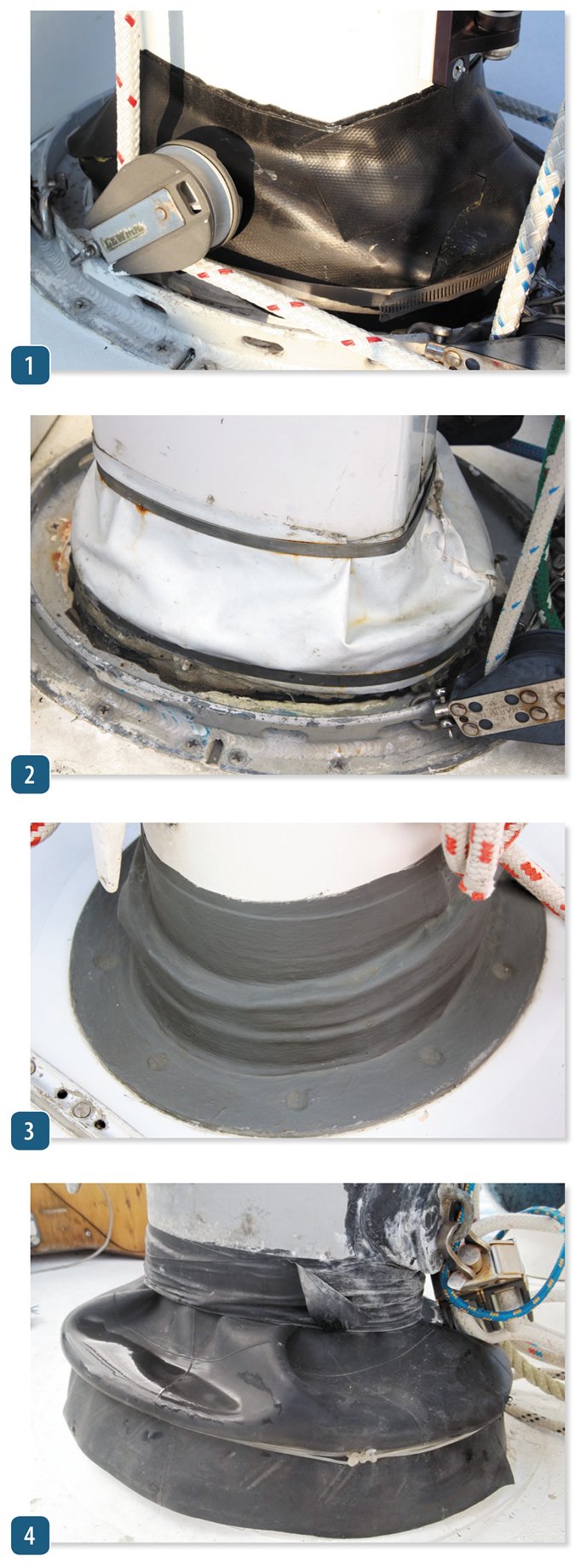
1 Roofing Rubber
One reliable boot sealer is self-adhesive ethylene propylene diene monomer (EPDM), a common rubber-membrane roofing material. Sold at local building supply stores, the rubber is black in color and comes in a roll that is 5 inches wide. (Dont confuse it with ice and water shield, which is much thinner.) Peeling the plastic backing from the underside of the EPDM material exposes the sticky side. Arrange precut strips prior to permanent installation. We suggest using American-made products as the imported stuff doesn’t adhere well to itself.
2 EPDM + plastic sheeting
A white, heavy, PVC plastic sheet can be installed over the EPDM for cosmetics and additional protection, or you can use it by itself. You can seal all of the overlapping seams at the mast with a medium-strength adhesive caulk like 3M 4000 UV. You also can seal any material held in place with hose clamps with butyl caulk (easier for disassembly later). Some cruisers have successfully installed only the plastic sheet as a mast boot.
3 Bandage Boot
Surprisingly, a common Ace bandage can be used to make a mast boot. Simply wrap the bandage around the mast, starting at the bottom and going up to 6 inches above the deck. Apply a thin coat of Hypalon paint (commonly used to waterproof RV roofs; Geocel is a common brand) to waterproof the bandage. To further protect the Hypalon from the suns ultraviolet (UV) rays, it might be worth applying a coat of exterior acrylic house paint, which will expand and contract and has better UV properties than an oil-based paint. (The mast boot pictured has lasted over four years without a leak.)
4 Truck tire tube
You can cut up an old truck-tire inner tube and wrap it around the mast, sealing the contact edges with butyl sealant. Seal the top with self-bonding rigging tape and secure the bottom with heavy monofilament fishing line. Seal the overlapping tube with contact cement or an adhesive sealant.
If you decide to go the retail route, there are very nice-looking, factory-made, contoured mast boots. But be sure to seal the area that joins the mast, under the retaining clamp, with butyl caulk rather than silicone. Butyl is far easier to remove with mineral spirits where silicone will need to be cut, scraped, and sanded from the mast. Where the mast boot overlaps, seal the seams with contact cement or an adhesive sealant.
RELATED ARTICLES MORE FROM AUTHOR
Or you can use Flex Seal.
Just removed my boot because the fabric cover was falling apart. Underneath was a car or truck inner tube that was cut to take advantage of the tube’s shape and overlapped at the back side. This was taped to the mast to seal the top. The bottom was not clamped. This was then covered with a fabric wrap using velcro and draw strings top and bottom. Surprisingly it never leaked.
LEAVE A REPLY Cancel reply
Log in to leave a comment
Latest Videos

Cabo Rico 34 Boat Review

Super Shallow Draft Sailboat: The Leeboard Sharpie

Hans Christian 41T – Boat Review

Seven dead after superyacht sinks off Sicily. Was the crew at...
Latest sailboat review.

- Privacy Policy
- Do Not Sell My Personal Information
- Online Account Activation
- Privacy Manager

What is a Sailboat Mast?
Published by sail on february 28, 2023 february 28, 2023.
A sailboat mast is a vertical pole or spar that rises from the deck of a sailboat and supports the sails. It is typically made of aluminum, carbon fiber, or wood, and can vary in size and shape depending on the size and type of the sailboat. The mast is usually stepped, or fixed, to the keel or hull of the boat, and its height determines the maximum height of the sails that can be used. The sails are attached to the mast using a variety of rigging and hardware, such as halyards, shrouds, and stays, which help to support the mast and distribute the loads created by the wind on the sails. The mast is a crucial component of a sailboat’s rigging, and its design and construction play an important role in the boat’s performance and handling.
When was the First Mast Created?
It is difficult to determine exactly when humans first created masts, as the development of sailing technology and the use of masts likely evolved gradually over thousands of years. However, there is evidence to suggest that masts were in use in the ancient world.
The oldest known depiction of a sailing vessel with a mast is from an Egyptian tomb dating back to around 3500 BCE. The boat depicted in the tomb has a single mast and a square sail. Masts were also used by ancient Greek and Roman sailors, who often used multiple masts on their vessels.
Over time, the design and construction of masts continued to evolve, with advancements in materials and rigging technology leading to taller and more efficient masts. In the Middle Ages, the use of multi-masted sailing ships became more common, with ships like the Viking longship and the carrack of the Age of Discovery featuring multiple masts.
Overall, while it is difficult to pinpoint the exact origins of the mast, it is clear that humans have been using this technology for thousands of years, and that the design and construction of masts has evolved significantly over time.
How many types of masts do exist for sailing tall ships? There are several types of masts that can be used on sailing tall ships, depending on the design of the ship and the type of sailing rig it uses. Here are some common types of masts:
- Foremast : The foremast is the mast nearest to the bow (front) of the ship. On square-rigged ships, the foremast carries square sails.
- Mainmast : The mainmast is the tallest mast in the center of the ship. It carries the largest square sails on a square-rigged ship.
- Mizzenmast : The mizzenmast is the third mast on a three-masted ship. It is located aft (near the stern) of the mainmast and carries triangular sails.
- Jiggermast : The jiggermast is the fourth mast on a four-masted ship. It is located aft of the mizzenmast and carries triangular sails.
- Bonaventure mast : The bonaventure mast is a smaller mast that is sometimes added to the aft end of the ship. It carries a small sail and is used to improve maneuverability.
- Spritsail mast : The spritsail mast is a short mast that extends from the bow of the ship and carries a triangular spritsail.
These are some common types of masts used on sailing tall ships, but there are many other variations and combinations of masts and sails that can be used depending on the specific design of the ship.
Which Materials are Modern Sailing Yacht Masts made of?
Modern sailing yacht masts are typically made from lightweight and strong materials that can withstand the loads and stresses created by the sails and rigging. Some common materials used in modern yacht mast construction include:
- Aluminum : Aluminum is a popular material for yacht masts due to its high strength-to-weight ratio, corrosion resistance, and ease of fabrication. Aluminum masts can be extruded or machined from solid billets, and are often used on smaller to mid-sized yachts.
- Carbon fiber : Carbon fiber is an increasingly popular material for yacht masts due to its exceptional strength-to-weight ratio, stiffness, and resistance to fatigue. Carbon fiber masts can be custom-designed and molded to specific shapes and sizes, making them a popular choice for high-performance racing yachts.
- Wood : While less common than aluminum or carbon fiber, wood masts are still used on some modern sailing yachts, particularly those designed for traditional or classic aesthetics. Wood masts are often made from high-quality, lightweight timbers such as Sitka spruce or Douglas fir, and are typically coated with protective finishes to resist rot and decay.
Other materials such as stainless steel, titanium, and composites may also be used in mast construction, depending on the specific needs and requirements of the yacht. Ultimately, the choice of mast material will depend on a variety of factors, including the size and type of the yacht, its intended use, and the owner’s preferences and budget.
How Many Masts can a Modern Sailing Boat have?
Modern sailing boats can have a varying number of masts depending on their size and design. Some common types of modern sailing boats and the number of masts they typically have include:
- Dinghies and small sailboats: These are typically single-masted boats, with the mast located in the center of the boat.
- Sloops : A sloop is a type of sailboat that has a single mast and a fore-and-aft rig, meaning that the sails run parallel to the length of the boat. This is the most common configuration for modern sailing boats up to around 40-50 feet in length.
- Cutters : A cutter is a type of sailboat that has two masts, with the mainmast located near the center of the boat and a shorter mast located near the bow (front) of the boat. Cutters typically have a mainsail and a headsail on the mainmast, and a staysail on the second mast.
- Ketches : A ketch is a type of sailboat that has two masts, with the mainmast located near the center of the boat and a smaller mast located aft of the mainmast. Ketches typically have a mainsail and a headsail on the mainmast, and a mizzen sail on the second mast.
- Schooners : A schooner is a type of sailboat that has two or more masts, with the forward mast (called the foremast) typically shorter than the mainmast. Schooners are typically rigged with fore-and-aft sails on both masts, and may also have additional square sails on the mainmast.
- Yawls : A yawl is a type of sailboat that has two masts, with the mainmast located near the center of the boat and a shorter mast located aft of the rudder post. Yawls typically have a mainsail and a headsail on the mainmast, and a mizzen sail on the second mast.
In general, modern sailing boats can have anywhere from one to four masts, depending on their size and design. Larger sailing ships, such as tall ships or square-riggers, may have even more masts.
Are racing sailboat masts different from normal ones?
Yes, racing sailboat masts can be different from normal cruising or recreational sailboat masts in several ways. Racing sailboats are typically designed to be faster and more maneuverable than cruising boats, and their masts are often optimized for performance and weight savings. Some ways that racing sailboat masts can differ from normal ones include:
- Material : Racing sailboat masts are often made from high-performance materials such as carbon fiber, which is lighter and stiffer than traditional materials like aluminum or wood. This can help reduce weight and increase stiffness, which can lead to better performance and handling.
- Design : Racing sailboat masts may be designed to be more aerodynamic than normal masts, with thinner profiles and more streamlined shapes. This can help reduce wind resistance and improve boat speed.
- Rigging : Racing sailboat masts may have more advanced rigging systems, with multiple halyards and lines that can be adjusted quickly and easily to fine-tune the sails and optimize boat speed. They may also have more sophisticated sail controls, such as traveler systems or adjustable backstays, that allow the crew to tweak sail shape and trim for maximum performance.
- Height : Racing sailboat masts may be taller than normal masts, which can increase sail area and leverage for better performance in light wind conditions. However, taller masts can also increase the risk of capsizing or broaching in strong winds, so they must be carefully balanced against other design factors.
Overall, racing sailboat masts are designed to be high-performance, lightweight, and optimized for speed and maneuverability. While they may be more expensive and require more maintenance than normal masts, they can be an important factor in achieving top-level performance in racing sailboats.
Which are the Weakest Point of a Sailing Yacht Mast?
The weakest point of a sailing yacht mast can vary depending on the design and materials used, but there are a few common areas that are often considered potential weak points:
- The masthead : The masthead is the top of the mast, where the rigging and sails are attached. This area can be subjected to a lot of stress and strain, especially in heavy wind conditions or when sailing upwind. The masthead fittings and rigging must be carefully designed and maintained to avoid failure or damage.
- The base of the mast: The base of the mast is where it is attached to the boat, either by a deck-stepped or keel-stepped configuration. This area can be subject to a lot of bending and twisting forces, especially in heavy seas or rough conditions. The mast step and support structure must be designed to handle these loads and avoid damage or failure.
- The spreaders : The spreaders are horizontal arms that extend from the mast to support the rigging and sails. They are often subjected to twisting forces and can be vulnerable to fatigue or cracking over time. Spreaders must be carefully designed and maintained to avoid failure or damage.
- The mast itself: The mast is a long, slender structure that is subject to bending and twisting forces from the wind and waves. Over time, this can lead to fatigue or damage in the mast structure, especially in high-performance racing masts or those made from lightweight materials like carbon fiber. Proper maintenance and inspection can help detect and prevent these issues.
Overall, the weakest point of a sailing yacht mast will depend on a variety of factors, including the design, materials, and usage patterns of the boat. Regular inspection and maintenance of the mast and rigging can help identify potential weak points and prevent damage or failure.
How Masts are Connected to Sailing Boats?
There are two common ways that masts are connected to sailing boats: deck-stepped and keel-stepped.
- Deck-stepped masts : A deck-stepped mast is attached to the deck of the boat, usually through a mast step or partner that distributes the load of the mast across a wider area of the deck. The bottom of the mast may be held in place by stays or shrouds, which are attached to the sides of the boat and help support the mast against lateral forces. Deck-stepped masts are commonly used on smaller sailboats, where they are easier to step and unstep for trailering or transport.
- Keel-stepped masts : A keel-stepped mast is attached to the boat’s keel, either directly or through a support structure. This provides a more secure and stable connection for the mast, as the keel can help distribute the loads from the mast across the entire hull. The bottom of the mast is typically supported by a mast step or bearing that is attached to the keel or hull, while the top of the mast is held in place by stays or shrouds. Keel-stepped masts are commonly used on larger sailboats, where they provide a more secure and stable platform for the rigging and sails.
Both deck-stepped and keel-stepped masts have their advantages and disadvantages, and the choice between them will depend on factors like the size and type of the boat, the intended use of the boat, and personal preferences of the owner. Regardless of the type of mast connection used, it is important to ensure that the mast and rigging are properly maintained and inspected to avoid damage or failure.
Related Posts

Cutter or Sloop Rig? Which is Best for Offshore and Ocean Cruising
When it comes to offshore and ocean cruising, choosing the right rig for your sailboat is crucial. Two popular options that often come up in discussions are the cutter rig and the sloop rig. Each Read more…

Tips & Tricks of a Sailboat Liveaboard Galley
A well-designed sailboat liveaboard galley should be functional, comfortable, and practical for long-term living and sailing. Here are some features to consider when designing or selecting a sailboat liveaboard galley: Space optimization: Utilize the limited Read more…

What is a Sailing Boat Hull?
What is a Sailing Boat Hull? A sailing boat hull is the main body of a sailing vessel that provides buoyancy and shape to the boat. It is the part of the boat that sits Read more…
Subscribe to our newsletter
Don’t miss new updates on your email.
© OceanWave Sail. All Rights Reserved 2022
Terms & Conditions – Privacy Policy – Cookie Policy
About Us – Privacy Policy
- New account
Forgot your password?
Lost your password? Please enter your email address. You will receive mail with link to set new password.
Back to login
Privacy Overview
| Cookie | Duration | Description |
|---|---|---|
| _GRECAPTCHA | 5 months 27 days | This cookie is set by the Google recaptcha service to identify bots to protect the website against malicious spam attacks. |
| apbct_cookies_test | session | CleanTalk sets this cookie to prevent spam on comments and forms and act as a complete anti-spam solution and firewall for the site. |
| apbct_page_hits | session | CleanTalk sets this cookie to prevent spam on comments and forms and act as a complete anti-spam solution and firewall for the site. |
| apbct_prev_referer | session | Functional cookie placed by CleanTalk Spam Protect to store referring IDs and prevent unauthorized spam from being sent from the website. |
| apbct_site_landing_ts | session | CleanTalk sets this cookie to prevent spam on comments and forms and act as a complete anti-spam solution and firewall for the site. |
| apbct_site_referer | 3 days | This cookie is placed by CleanTalk Spam Protect to prevent spam and to store the referrer page address which led the user to the website. |
| apbct_timestamp | session | CleanTalk sets this cookie to prevent spam on comments and forms and act as a complete anti-spam solution and firewall for the site. |
| apbct_urls | 3 days | This cookie is placed by CleanTalk Spam Protect to prevent spam and to store the addresses (urls) visited on the website. |
| cookielawinfo-checkbox-advertisement | 1 year | Set by the GDPR Cookie Consent plugin, this cookie is used to record the user consent for the cookies in the "Advertisement" category . |
| cookielawinfo-checkbox-analytics | 11 months | This cookie is set by GDPR Cookie Consent plugin. The cookie is used to store the user consent for the cookies in the category "Analytics". |
| cookielawinfo-checkbox-functional | 11 months | The cookie is set by GDPR cookie consent to record the user consent for the cookies in the category "Functional". |
| cookielawinfo-checkbox-necessary | 11 months | This cookie is set by GDPR Cookie Consent plugin. The cookies is used to store the user consent for the cookies in the category "Necessary". |
| cookielawinfo-checkbox-others | 11 months | This cookie is set by GDPR Cookie Consent plugin. The cookie is used to store the user consent for the cookies in the category "Other. |
| cookielawinfo-checkbox-performance | 11 months | This cookie is set by GDPR Cookie Consent plugin. The cookie is used to store the user consent for the cookies in the category "Performance". |
| CookieLawInfoConsent | 1 year | Records the default button state of the corresponding category & the status of CCPA. It works only in coordination with the primary cookie. |
| ct_checkjs | session | CleanTalk–Used to prevent spam on our comments and forms and acts as a complete anti-spam solution and firewall for this site. |
| ct_fkp_timestamp | session | CleanTalk sets this cookie to prevent spam on the site's comments/forms, and to act as a complete anti-spam solution and firewall for the site. |
| ct_pointer_data | session | CleanTalk sets this cookie to prevent spam on the site's comments/forms, and to act as a complete anti-spam solution and firewall for the site. |
| ct_ps_timestamp | session | CleanTalk sets this cookie to prevent spam on the site's comments/forms, and to act as a complete anti-spam solution and firewall for the site. |
| ct_sfw_pass_key | 1 month | CleanTalk sets this cookie to prevent spam on comments and forms and act as a complete anti-spam solution and firewall for the site. |
| ct_timezone | session | CleanTalk–Used to prevent spam on our comments and forms and acts as a complete anti-spam solution and firewall for this site. |
| elementor | never | This cookie is used by the website's WordPress theme. It allows the website owner to implement or change the website's content in real-time. |
| JSESSIONID | session | The JSESSIONID cookie is used by New Relic to store a session identifier so that New Relic can monitor session counts for an application. |
| viewed_cookie_policy | 11 months | The cookie is set by the GDPR Cookie Consent plugin and is used to store whether or not user has consented to the use of cookies. It does not store any personal data. |
| Cookie | Duration | Description |
|---|---|---|
| _zcsr_tmp | session | Zoho sets this cookie for the login function on the website. |
| Cookie | Duration | Description |
|---|---|---|
| __gads | 1 year 24 days | The __gads cookie, set by Google, is stored under DoubleClick domain and tracks the number of times users see an advert, measures the success of the campaign and calculates its revenue. This cookie can only be read from the domain they are set on and will not track any data while browsing through other sites. |
| _ga | 2 years | The _ga cookie, installed by Google Analytics, calculates visitor, session and campaign data and also keeps track of site usage for the site's analytics report. The cookie stores information anonymously and assigns a randomly generated number to recognize unique visitors. |
| _ga_SMBZQHCWN2 | 2 years | This cookie is installed by Google Analytics. |
| _ga_W40VWSXK09 | 2 years | This cookie is installed by Google Analytics. |
| _gat_gtag_UA_231294427_1 | 1 minute | Set by Google to distinguish users. |
| _gid | 1 day | Installed by Google Analytics, _gid cookie stores information on how visitors use a website, while also creating an analytics report of the website's performance. Some of the data that are collected include the number of visitors, their source, and the pages they visit anonymously. |
| CONSENT | 2 years | YouTube sets this cookie via embedded youtube-videos and registers anonymous statistical data. |
| Cookie | Duration | Description |
|---|---|---|
| test_cookie | 15 minutes | The test_cookie is set by doubleclick.net and is used to determine if the user's browser supports cookies. |
| Cookie | Duration | Description |
|---|---|---|
| __gpi | 1 year 24 days | No description |
| 1e5a17c8ab | session | No description available. |
| apbct_headless | session | No description |
| apbct_pixel_url | session | No description |
| ct_checked_emails | session | No description |
| ct_has_scrolled | session | No description |
| ct_screen_info | session | No description |
| ZCAMPAIGN_CSRF_TOKEN | session | No description available. |
| (001) 401-739-1140 -- (001) 401-739-1149 ---
|
Rigging - Turnbuckles , Toggles , Wire & Rod Components, Norseman Cones & Fittings.
Furling Systems - Systems and replacement parts from a variety of Manufacturers.
Traveller Systems - Adjustable Track Systems for Mainsheet and other applications.
Sailboat Hardware - Rope Clutches, Blocks, Track & Fittings, Winches, etc.
Custom Parts - Custom items, or those out of production or otherwise unavailable.
Consultation - Special projects, research, or information not detailed on-site.
Copyright 1996 - 2024, Rig-Rite, Inc. Disclaimer Web Site maintained by The WATER Group
Parts Of a Sail Explained (Illustrated Beginners Guide)
Are you curious about sail mechanics and how they engage the wind? In this illustrated guide, we'll explain the various sail components and how they work together to propel a sailboat. From the head to the foot, the tack to the clew, we'll break down each part and give you a solid foundation to build on as you learn to trim sails and navigate the open sea.
A sail, which is a large piece of fabric that is attached to a long pole called the mast, uses the wind to pull a sailboat across the water. It has various parts, such as the head, tack, clew, luff, leech, foot, mainsail, jib, and batten. These components determine the shape and efficiency of the sail.
Let's break down all these terms and descriptions to understand how each component interacts with each other. So, whether you're a seasoned sailor or a beginner, you'll have a better grasp of sail trim and optimal performance on the water.
- The primary parts of a mainsail include the head, tack, clew, luff, leech, and foot.
- Some critical elements of the jib include the sheet, genoa, and headstay.
- Asymmetrical spinnakers are designed for off-wind sailing and have a more rounded shape, while symmetrical spinnakers are used for downwind sailing and have a more traditional, triangular shape.
- The most common fabrics used for making sails are traditional fabrics like cotton and flax, and modern fabrics such as polyester and nylon, Dacron, Mylar, and laminates.
- Be sure to learn how to properly trim, reef, clean, flake, and store your sails for durability and optimal performance.
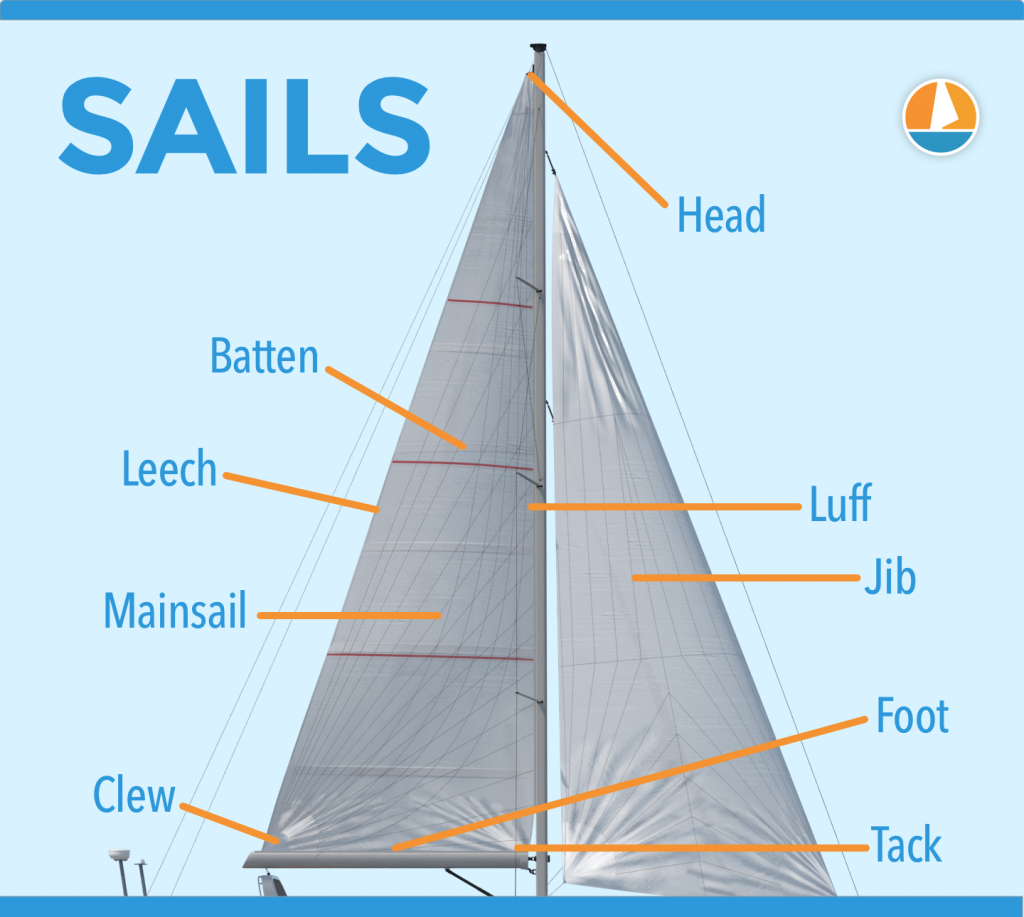
On this page:
Parts of a sail and their functions, mainsail components, jib components of a sailboat, components of spinnakers, sail controls and settings, sail care and maintenance, sail materials and construction.
In this guide, we'll focus on the three main types of sails : Mainsail, Jib, and Spinnaker.
Mainsail is the primary sail on your boat
The mainsail is the largest sail on a sailboat and is typically attached to the mast and boom. It is found aft (rear) of the mast. It's attached to the boat through a track or sail slide, which allows it to move up and down.
| Description | |
|---|---|
| the very top of the sail that is attached to the mast | |
| the bottom edge of the sail that is attached to the boom | |
| the front, leading edge of the sail that runs along the mast | |
| the trailing edge of the sail that runs from the head to the clew | |
| the bottom front corner of the sail | |
| the bottom aft corner of the sail that is attached to the boom | |
| are thin, flat strips of material (such as fiberglass or wood) that are inserted into pockets in the sail to help it maintain its shape and prevent it from flapping in the wind | |
| are sets of small lines or ties that are used to reduce the size of the sail in high winds | |
| are small pieces of ribbon or yarn that are attached to the sail to help the sailor determine the direction and strength of the wind | |
| are numbers that are affixed to the sail to identify the boat in racing situations | |
| include lines or sheets that are used to control the shape and position of the sail, such as the mainsheet, outhaul, and cunningham |
Jib is a triangular sail placed in front of the boat
The jib is a smaller sail that is attached to the bow of the boat and works in conjunction with the mainsail to control the direction and speed of the boat. It helps to improve the boat's handling and increase speed, working in tandem with the mainsail.
| Description | |
|---|---|
| the top of the sail that is attached to the forestay | |
| the leading edge of the sail that runs along the forestay | |
| the bottom edge of the sail that is attached to the deck or a furling drum | |
| the trailing edge of the sail that runs from the head to the clew | |
| the corner of the sail that is attached to the deck or a furling drum | |
| are small pieces of ribbon or yarn that are attached to the sail to help the sailor determine the direction and strength of the wind | |
| are lines that are used to control the position and trim of the sail | |
| a device that allows the jib to be rolled up and stored when not in use | |
| are clips that are used to attach the jib to the forestay on boats that do not have a furling drum | |
| the bottom forward corner of the jib that is attached to the boat's bow |
In some cases, larger jibs called genoas are used to capture more wind, thus increasing the boat's speed.
Spinnaker is designed for sailing downwind
The spinnaker is a large, colorful, and lightweight balloon-shaped sail designed for sailing downwind. It captures the wind from the rear, pushing the boat forward with added speed and stability.
| Description | |
|---|---|
| the top of the sail that is attached to a spinnaker halyard | |
| the leading edge of the sail that runs along the spinnaker pole | |
| the bottom edge of the sail that is attached to the spinnaker tack line | |
| the trailing edge of the sail that runs from the head to the clew | |
| the corner of the sail that is attached to the spinnaker sheet | |
| a long, horizontal pole that is attached to the mast and used to hold the spinnaker out from the boat | |
| a line that is attached to the spinnaker pole and used to control its position | |
| a line that is attached to the clew of the spinnaker and used to control its position and trim | |
| a line that is attached to the lower forward corner of the spinnaker and used to control its position | |
| a device that is used to control the spinnaker when it is being raised or lowered |
In this section, you'll find a comprehensive explanation of the primary components of a sail and their functions:
Head is the uppermost corner of a sail
The head of the sail refers to the uppermost corner where it connects to the top of the mast. Knowing the location of the head is essential, as it helps you identify the top of the sail and allows you to properly hoist and secure it in place.
Tack is the lower front corner of a sail
The tack is where the lower front corner connects to the base of the mast, or the boom. This important point helps you determine the sail's orientation and affects its overall shape and efficiency. By adjusting the tension at the tack, you can control your sail's performance and handling in various wind conditions.
Clew is the lower rear corner of a saisl
The clew is where the sheets attach to control the sail's angle to the wind. Adjusting the tension on the sheets can change the sail's shape and ultimately influence the boat's speed and direction. Becoming familiar with the clew will help improve your sailing skills and ensure smooth maneuvers on the water.
Luff is the front edge of the sail
The luff is the forward edge of the sail that runs along the mast. It's crucial to maintaining a tight and efficient sail shape. When sailing upwind, pay close attention to the luff, as it can provide valuable information about your sail's trim. A properly trimmed sail will have a smooth luff, allowing the boat to move efficiently against the wind.
Leech is the rear edge of the sail
The leech is opposite the luff. It plays a critical role in controlling the overall shape and efficiency of your sail. Watch the leech carefully while sailing, as excessive tension or looseness can negatively affect your sail's performance. Adjusting your sail's trim or using a device called a "boom vang" can help control the shape and tension of the leech.
Foot is the bottom edge of the sail
The foot is running between the tack and the clew. It helps control the shape and power of the sail by adjusting the tension along the boom. Ensure the foot is properly trimmed, as this can impact your boat's performance and speed. A well-adjusted foot helps your sail maintain its proper shape and operate at optimal efficiency while out on the water.
In this section, we'll look at some critical elements of the jib: the sheet, genoa, and headstay.
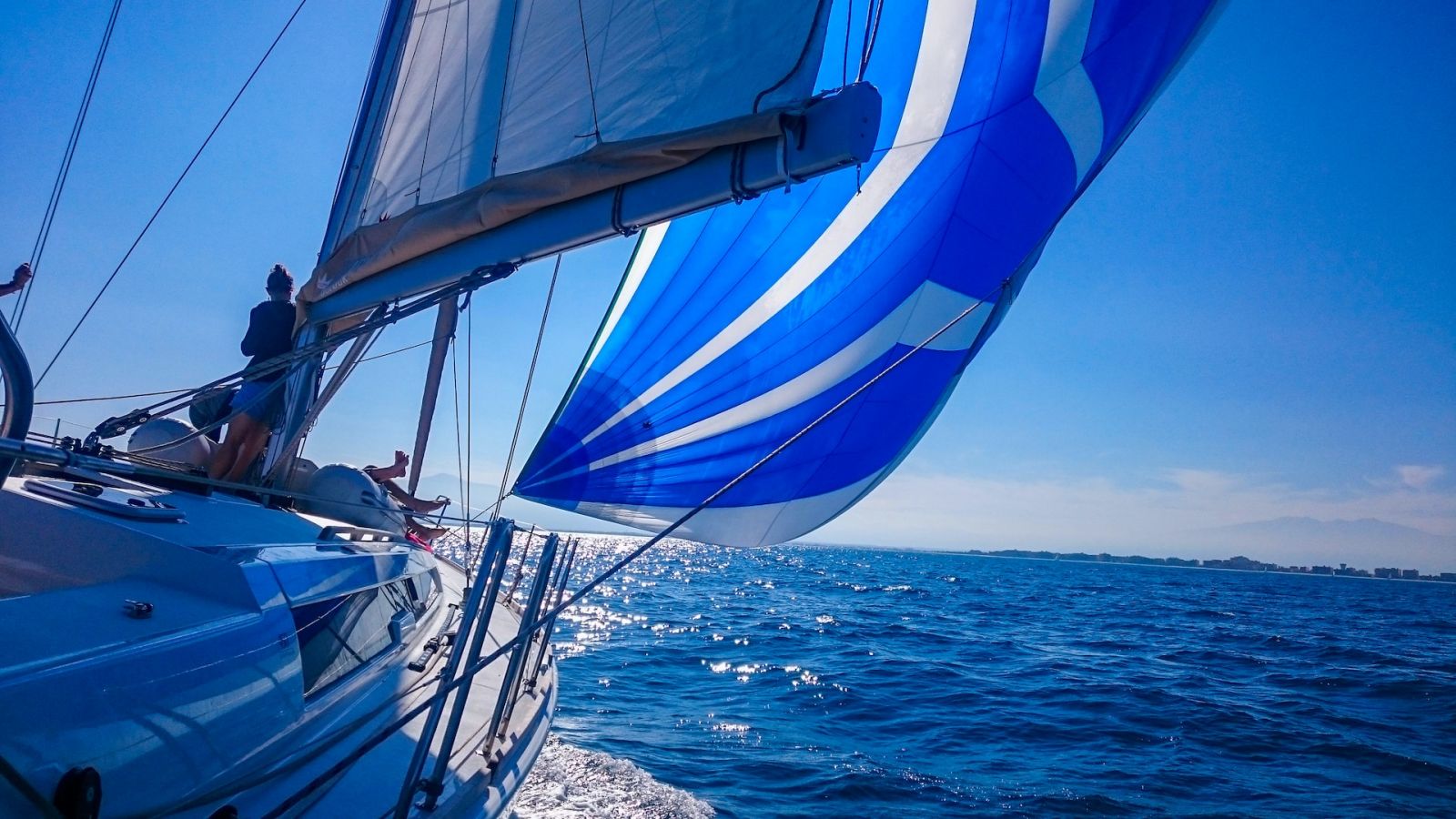
Sheet is the line used to control the position and trim of the sail
The jib sheet is the line used to control the jib's angle in relation to the wind. You adjust the sheet to get the best possible sail trim, which greatly affects your boat's performance. The jib sheet typically runs from the jib's clew (the lower rear corner of the sail) through a block on the boat's deck, and back to the cockpit, where you can easily control it.
When adjusting the jib sheet, you want to find the perfect balance between letting the sail out too far, causing it to luff (flutter), and pulling it in too tightly, which can cause heeling or poor sail shape. Make small adjustments and observe how your boat responds to find the sweet spot.
Genoa is a larger jib used to capture more wind
A genoa is a larger version of a standard jib. It overlaps the mainsail, extending further aft, and provides a greater sail area for improved upwind performance. Genoas are categorized by the percentage of overlap with the mainsail. For example, a 130% genoa means that the sail's area is 30% larger than the area of a jib that would end at the mast.
Genoas are useful in light wind conditions, as their larger surface area helps your boat move faster. However, they can become difficult to manage in strong winds. You might need to reef (reduce the size) or swap to a smaller jib to maintain control.
Headstay provides a support structure for the jib
The headstay is a crucial part of your boat's standing rigging system. It is the cable or rod that connects the top of the mast (the masthead) to the bow of the boat. The headstay helps maintain the mast's stability and provides a support structure for the jib.
The tension in your headstay plays a significant role in the jib's sail shape. Proper headstay tension will create a smooth, even curve, allowing your jib to perform optimally. If the headstay is too tight, the sail may be too flat, reducing its power, whereas a loose headstay can result in a sagging, inefficient sail shape.
A spinnaker is a sail designed specifically for sailing off the wind , on courses between a reach and downwind. They are made of lightweight fabric, often brightly colored, and help maximize your sailing speed and performance.
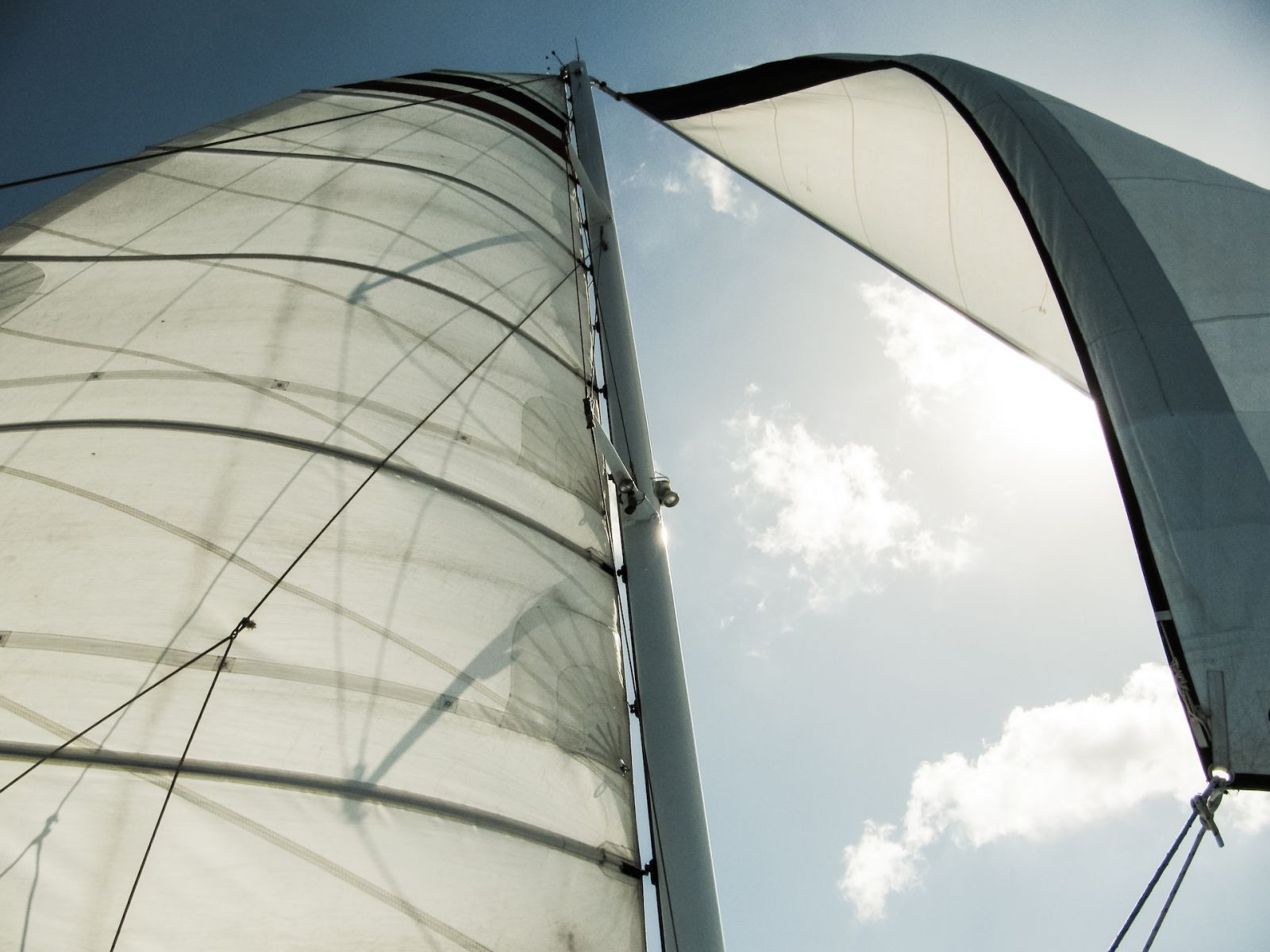
Asymmetrical spinnakers are designed for off-wind sailing
Asymmetrical spinnakers are usually found on modern cruising and racing boats. They're designed for a broader range of wind angles and have a more forgiving shape, making them easier for you to handle. Key components of an asymmetrical spinnaker include:
- Tack : This is the front, lower corner where the sail connects to the boat. A tack line is used to adjust the sail's position relative to the bow.
- Head : The top corner of the sail, where it connects to the halyard to be hoisted up the mast.
- Clew : The aft corner of the sail, connected to the sheet, allowing you to control the angle of the sail to catch the wind effectively.
You can find a step-by-step guide on how to rig and hoist an asymmetrical spinnaker here .
Symmetrical spinnakers are used for downwind sailing
Symmetrical spinnakers are more traditional and usually found on racing boats, where downwind performance is critical. These sails are shaped like a large parachute and are split into two identical halves. Key components of a symmetrical spinnaker include:
- Head : Similar to the asymmetrical spinnaker, the head is the top corner connected to the halyard.
- Clews : Unlike an asymmetrical spinnaker, a symmetrical spinnaker has two clews. Both are connected to sheets and guys, which help control the sail's shape and movement.
- Spinnaker Pole : This is a horizontal pole that extends from the mast and is used to project the windward clew outwards and hold the sail open.
Handling a symmetrical spinnaker can be more challenging, as it requires precise teamwork and coordination. If you're new to sailing with this type of sail, don't hesitate to seek guidance from experienced sailors to improve your technique.
In this section, we'll explore sail controls and settings, which are essential for beginners to understand for efficient sailing. We'll discuss trimming, and reefing, as sub-sections.
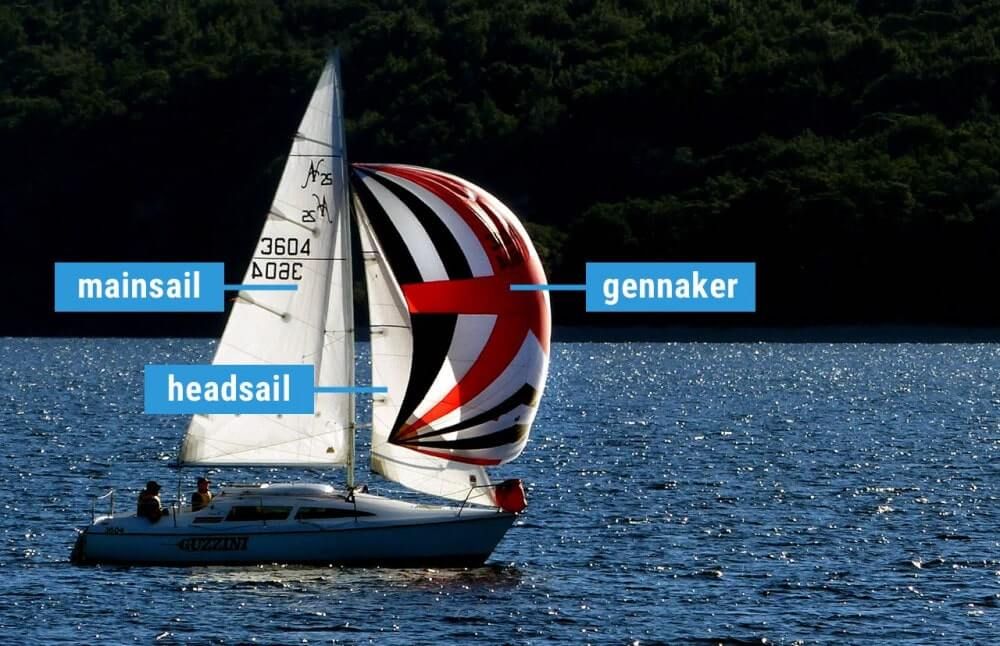
Trimming your sails for speed and stability
Trimming is the process of adjusting your sails to optimize them for the current wind conditions and desired direction. Proper sail trim is crucial for maximizing your boat's speed and stability. Here are some basic tips for sail trimming:
- Pay attention to the telltales, which are small ribbons or yarn attached to the sails. They help you understand the airflow over your sails and indicate whether they're properly trimmed.
- Use the sheets, which are lines attached to the clew of your sails, to adjust the angle of your sails relative to the wind.
- In light winds, ease the sails slightly to create a more rounded shape for better lift. In stronger winds, flatten the sails to reduce drag and prevent excessive heeling.
Reefing your sails for control and balance
Reefing is the process of reducing the sail area to help maintain control and balance in stronger wind conditions. It's an essential skill to learn for your safety and the longevity of your sails. Follow these steps to reef your sails:
- Head into the wind to reduce pressure on the sails.
- Lower the halyard (the line that raises the sail) until the sail reaches the desired reefing point.
- Attach the sail's reefing cringle (reinforced eyelet) to the reefing hook or tack line.
- Tighten the new, lower clew (bottom corner) of the sail to the boom with the reef line.
- Raise the halyard back up to tension the reduced sail.
Take proper care of your sailboat to ensure that it remains in top condition. In this section, we will discuss the key aspects of sail care and maintenance, focusing on cleaning and storage.
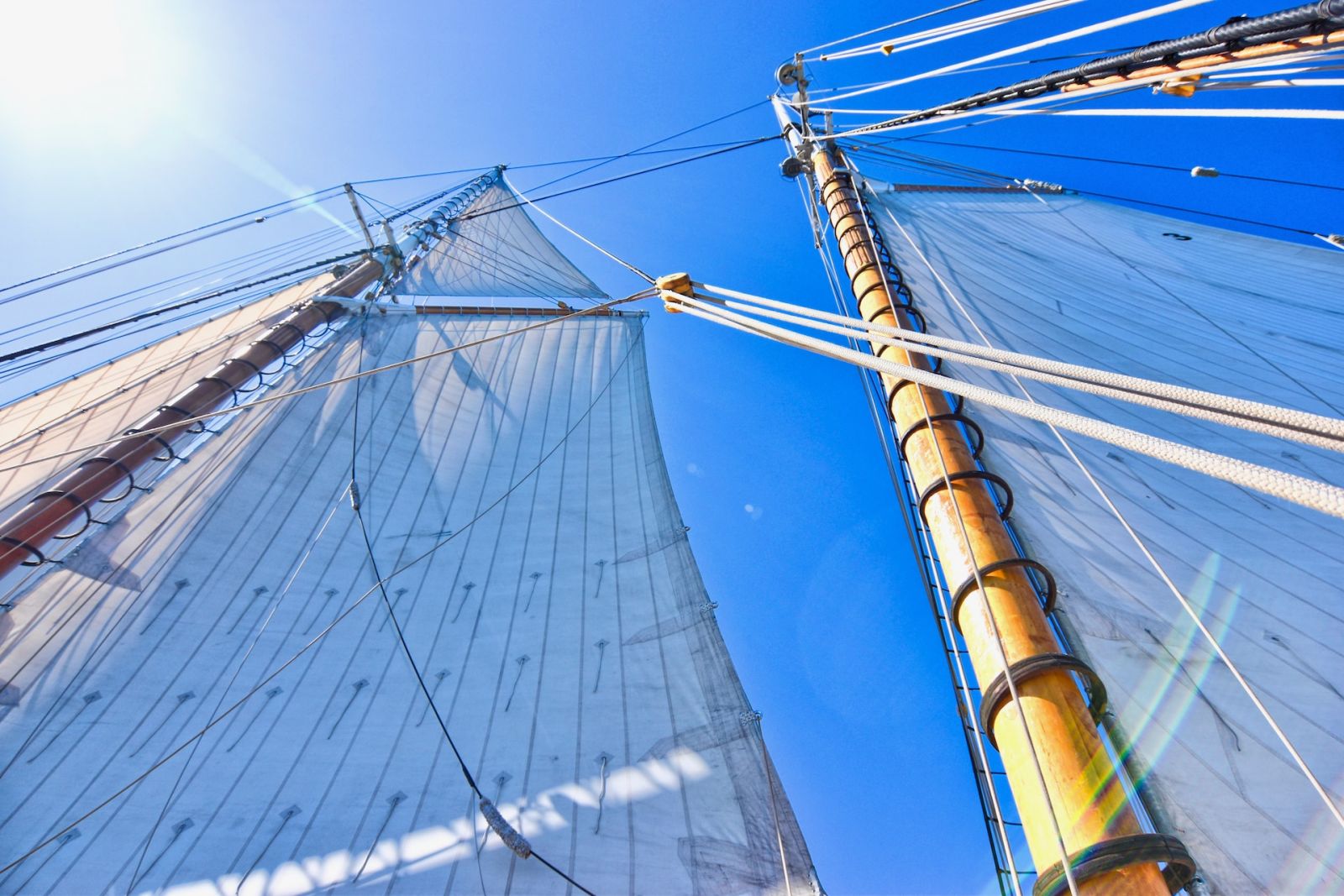
Steps to clean your sails
Keeping your sail clean is crucial for its longevity and performance. Follow these simple steps to maintain a spotless sail:
- Rinse with fresh water after each use, paying extra attention to areas affected by saltwater, debris, and bird droppings.
- Use a soft-bristled brush and a mild detergent to gently scrub away dirt and stains. Avoid harsh chemicals or abrasive materials, as they may damage the fabric.
- Rinse again thoroughly, ensuring all soap is washed away.
- Spread your sail out to air-dry, avoiding direct sunlight, which may harm the fabric's UV protection.
Ways to store your sails
Sail storage is equally important for preserving the lifespan of your sail. Here are some tips for proper sail storage:
- Fold or roll your sail : Avoid stuffing or crumpling your sail; instead, gently fold or roll it to minimize creases and wear on the fabric.
- Protect from UV rays : UV exposure can significantly reduce the life of your sail. Store it in a cool, shaded area or use a UV-resistant sail cover when not in use.
- Ventilation : Ensure your sail is stored in a well-ventilated area to prevent mildew and stale odors.
- Lay flat or hang : If space allows, store your sail laid out flat or hanging vertically to reduce the risk of creasing and fabric damage.
Flaking your sails when not in use
Flaking is the process of neatly folding your sails when they're not in use, either on the boom or deck. This helps protect your sails from damage and prolongs their lifespan. Here's how to flake your sails:
- Lower the sail slowly, using the halyard while keeping some tension on it.
- As the sail comes down, gather and fold the sail material in an accordion-like pattern on top of the boom or deck.
- Secure the flaked sail with sail ties or a sail cover to prevent it from coming undone.
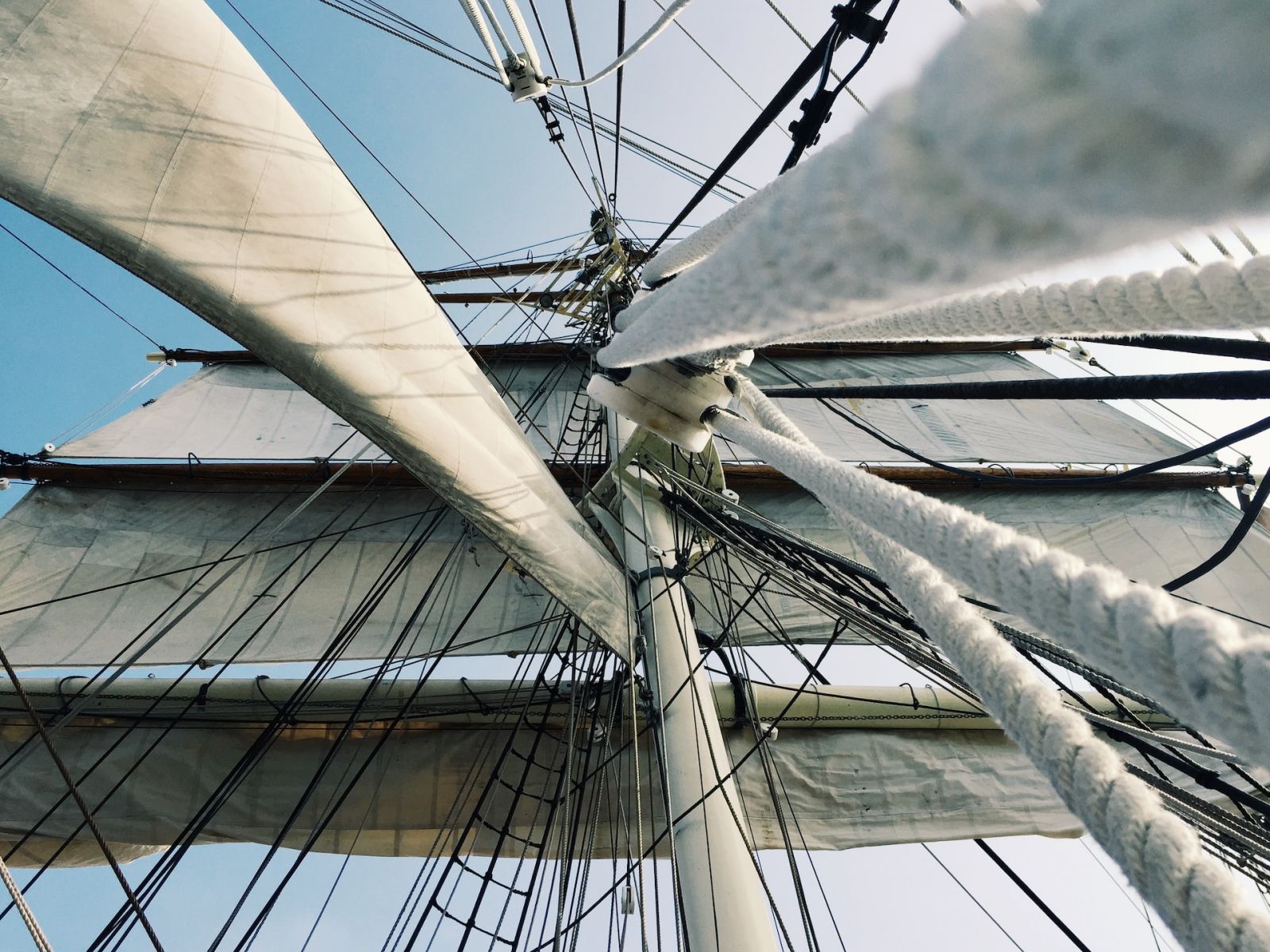
Traditional fabrics used to make sails
In the early days of sailing, natural materials like cotton and flax were used to make sails. These fabrics were durable, breathable, and held up well in various weather conditions. However, they would eventually wear out and lose their shape due to the constant exposure to UV rays and seawater.
While traditional fabrics like cotton and flax were once commonly used for sailmaking, they have largely been replaced by synthetic materials like polyester and nylon due to their superior strength, durability, and resistance to mildew and rot. However, some sailors and sailmakers still use cotton and other natural fibers for certain applications, such as traditional sailmaking or historical recreations.
Modern fabrics used to make sails
Modern sail materials, such as Dacron, Mylar, and laminates, are more resilient and longer-lasting than traditional fabrics. These materials are lightweight, strong, and resistant to UV rays and water damage.
Dacron : Dacron is a popular material for sails because of its durability, UV resistance, and ease of maintenance. It's a type of polyester fabric that is often used for making cruising sails. Dacron offers excellent shape retention and resistance to stretch, making it ideal for both beginners and experienced sailors.
Laminate materials : Laminate sails are made by bonding multiple layers of materials like Mylar, polyester, and Kevlar. These sails offer better shape and performance compared to their fabric counterparts, making them popular among racers. However, they tend to be more delicate and may not be suitable for long-term cruising.
Mylar films : Mylar films are used in laminate sails for their excellent strength-to-weight ratio and shape retention. These films are often sandwiched between other materials, such as polyester or Kevlar, to enhance the sail's resistance to stretch and load handling. However, Mylar sails can be susceptible to delamination and abrasion, requiring extra care and regular inspection.
Sail stitching for shape and durability
Sail stitching is an essential aspect of sail construction, helping to maintain the sail's shape and durability. Various stitching techniques can be used, such as zigzag, straight, and triple-step sewing. The choice of stitching type depends on the sail's purpose and expected loads. In addition, using UV-resistant thread ensures that the stitching lasts longer under harsh sun exposure.
Leave a comment
You may also like, how do sails actually work: full beginners guide.
The sails are your boat's primary driving force. Your boat is designed to sail , and with good wind it will be faster and more comfortable than using the engine. …

Sail Names: Explained for Beginners (With 15 Examples)

How To Trim Sails: The Ultimate Guide (with Cheat Sheet)

How To Reef Your Sails (Mainsail, Jib, Furling, Loose)

How Much Do New Sails Cost?
- Boat Reviews
- Industry Directory
- Accessories
Inside the America’s Cup: A Closer Look at AC75 Masts & Rigging
As the Round Robins progress and Barcelona delivers, the AC75 fleet is looking fast. Whether it’s the return of the cyclors, enhanced foil designs, aero improvements, or more advanced control systems, a range of technical innovations are frequently cited as the reason for driving this impressive performance. In this respect, one area that may have received less attention is the rig and rigging design. Yet, especially since the arrival of composite materials in the America’s Cup, it’s an area that has had a formative impact on how things play out on the water.

Southern Spars has played a leading role since entering the America’s Cup fold in 1995, with the supply of Team New Zealand ’s innovative high-performance carbon mast that took them to a historic victory. Southern Spars’ sister company , Future Fibres , is also increasingly central to the trajectory of composite innovation in the Cup .
Class Rules
AC75 class rules specify several key one design aspects of mast design and construction. They stipulate the shape (D-section) and the size (within a tolerance) of the mast tube. The Rule also dictate s the required carbon fibre specification, including the fibre modulus, a real weight, and resin content. Additionally, the geometry and material s of the fittings, such as shrouds and spreaders, mast rotation restriction to 45°, and the height of the mast rotation ball relative to the waterline are all defined by the rule.
Mast R otation
Through c ontrolling the 45° mast rotation , each team has at their disposal a mechanism to access enhanced power and performance. All AC37 participants have selected North Sails as their best option such is the compelling performance of the North Sails Helix structured luff technology, which has redefined what a sail can deliver —its internal structure enhancing power potential by controlling the load s through the sail structure , delivering a proactive, positive sail shape.
With a mast designed to react to the conditions by rotat ing to the exact degree needed to exploit every breath of wind and realis e the sail shape intended by the team’s sail designers, the benefits of Helix are taken to the extreme. You could almost say that the masts on AC75s have become part of the sail or the other way around, and it feels like the lines are blurring between the essential elements of the engine above deck.
Thickness and Stiffness
Another way masts influence sail shape is, of course, mast bend. This is the stand-out area where teams can differentiate their masts to influence performance. W hile the D-spar minimum laminate and core details are specified under AC37 c lass rules , teams are free to add more laminate if they choose to. There is always weight to performance trade-offs , but there is scope within the teams to increase the overall stiffness of the mast, or to alter the deflection response — optimising it to suit the desired degree of mast bend that the team’s sail designers are calling for.

No Backstay
While the rigging for AC37 is a fully one-design “supplied” component from by Future Fibres, identical onboard each AC75, some significant changes have been made to the rigging packages since the 36 th America’s Cup . One talking point is the elimination of the backstay, which also has a knock-on effect o n the wider engine above deck. Mast bend, which would conventionally be influenced by backstay control, is now almost solely manged by sail controls. Another knock-on effect is escalating load through the shrouds, which ha s required the cap shroud s to be enlarged and jib locks to be upgraded from 5t to 8t for this edition of the cup . One constant though, and a s per the AC 36 rule, the Future Fibres rigging package s are equipped with integrated fibre optic load monitoring, for performance analysis and to keep an eye on loading limits.
Looking Ahead
Beyond the talking points we have summarised here – luff tracks, batten stiffness, batten location s , halyard locks and mainsail controls – all sit within the remit of team designers. It remains to be seen which technical factors will rise to the surface during the 37 th America’s Cup, but it is a safe bet that ripple effects from technological choices and innovations will be felt around the wider sailing landscape in the coming years.

General Manager of Southern Spars, Mark Hauser comments, “We are immensely proud of our close partnerships with the teams and together we commit ourselves entirely to the pursuit of excellence. I nnovation in the Cup reverberate s around the industry for years the regatta and we are proud to be leading the charge with the world’s most elite sailing teams.”
Related Articles
This conversation is moderated by Boating New Zealand. Subscribe to view comments and join the conversation. Choose your plan →
LEAVE A REPLY Cancel reply
Log in to leave a comment

More from Boating New Zealand
.tdi_208{margin-top:-5pximportant;padding-top:0pximportant;width:100%important} .tdb_module_title{display:block;position:relative;margin:0;font-family:'roboto',sans-serif;font-size:21px;font-weight:400;line-height:1.2}.tdb_module_title a{transform:translatez(0);transition:box-shadow 0.2s ease;-webkit-transition:box-shadow 0.2s ease}.tdb_module_title .tdb-module-title-excl{font-family:'roboto',sans-serif;color:#fff;background-color:#ff0000;padding:4px 8px 2px;margin-right:8px;font-size:14px;font-weight:500;line-height:1;vertical-align:middle}.tdb_module_template_115338 .tdc-row .tdb_module_title_0{text-align:left;font-family:var(--headings)important;font-size:30pximportant;line-height:1.2important;font-weight:600important;text-transform:capitalizeimportant;letter-spacing:.8pximportant}.tdb_module_template_115338 .tdc-row .tdb_module_title_0 a{color:#000000} bumpy seas and stronger winds ..., .tdi_221{margin-top:-5pximportant;padding-top:0pximportant;width:100%important} strong winds and heavy rain le..., .tdi_234{margin-top:-5pximportant;padding-top:0pximportant;width:100%important} meet the young kiwi’s wh..., .tdi_247{margin-top:-5pximportant;padding-top:0pximportant;width:100%important} youth america’s cup raci..., .tdi_260{margin-top:-5pximportant;padding-top:0pximportant;width:100%important} hurricane boats hit the water ..., .tdi_273{margin-top:-5pximportant;padding-top:0pximportant;width:100%important} josh hyde and waitemata racing..., boating weekly.
Join Thousands of New Zealand Boating Enthusiasts! Exclusive deals, boat reviews, sports coverage, stories, and our best tips for NZ boaters ⏤ free and straight to your inbox.
HOT OFF THE PRESS
@media (max-width:767px){.tdi_300{margin-top:10pximportant}} .tdb_module_template_3638 .tdc-row .tdb_module_title_0{text-align:left}.tdb_module_template_3638 .tdc-row .tdb_module_title_0 a{color:#223c65}.tdb_module_template_3638 .tdc-row .tdb_module_title_0{font-family:"helvetica neue",helvetica,arial,sans-serifimportant;font-size:18pximportant;line-height:1.2important;font-weight:500important} bumpy seas and stronger winds will make youth america’s cup day 1 exciting, @media (max-width:767px){.tdi_309{margin-top:10pximportant}} strong winds and heavy rain lead to beaching and maritime warning, @media (max-width:767px){.tdi_318{margin-top:10pximportant}} meet the young kiwi’s who will do us proud in the youth america’s cup, @media (max-width:767px){.tdi_327{margin-top:10pximportant}} youth america’s cup racing kicks off tonight in barcelona, @media (max-width:767px){.tdi_336{margin-top:10pximportant}} hurricane boats hit the water in australia and new zealand.
Events Worth Adding to Your Calendar
Have an event you'd like to list on Boating New Zealand. Contact us with the details.
COMING EVENTS
Catch all the action of the Louis Vuitton 37th America's Cup , happening from 22 Aug to 27 Oct 2024 in Barcelona, Spain. Follow along with excitement at Boating New Zealand .
The Outdoor Expo , 14 & 15 Sep 2024 at Canterbury Agricultural Park
NZ Boat, Fish & Dive Expo , 31 Aug & 1 Sep 2024 at Mystery Creek Events Centre, Hamilton
NZ Millenium Cup , 1-4 Feb 2025 at Bay of Islands
Auckland Boat Show , 6-9 March 2025 at Viaduct Events Centre and Jellicoe Harbour, Auckland
The Hutchwilco New Zealand Boat Show , 15-18 May 2025 at Auckland Showgrounds, Auckland
NEWS TIPS? Send your photos, videos, stories, and tip-offs to [email protected] or call us on 022-023-7507.
ADVENTURES AT SEA
@media (max-width:767px){.tdi_384{margin-top:10pximportant}} .tdb_module_template_127943 .tdc-row .tdb_module_title_0{text-align:left}.tdb_module_template_127943 .tdc-row .tdb_module_title_0 a{color:#000000}.tdb_module_template_127943 .tdc-row .tdb_module_title_0{font-family:"helvetica neue",helvetica,arial,sans-serifimportant;font-size:18pximportant;line-height:1.2important;font-weight:500important} when a series of unfortunate events force an unexpected u-turn, @media (max-width:767px){.tdi_393{margin-top:10pximportant}} one family’s boating journey; that sinking feeling, @media (max-width:767px){.tdi_402{margin-top:10pximportant}} one family’s boating journey: life lessons, @media (max-width:767px){.tdi_411{margin-top:10pximportant}} one family’s boating journey; racing to whangamata, @media (max-width:767px){.tdi_420{margin-top:10pximportant}} one family’s boating journey: a bridge too far.
Sailboat Mast Step: Everything You Need to Know
by Emma Sullivan | Aug 22, 2023 | Sailboat Maintenance

Short answer sailboat mast step:
The sailboat mast step is a structural component located at the base of the mast, designed to support and secure the mast to the deck. It provides stability and distributes the loads generated by the sail rigging.
The Importance of a Sailboat Mast Step: Guide to Understanding the Basics
Title: Navigating the High Seas: Unveiling the Crucial Role of a Sailboat Mast Step – An Insightful Guide to Mastering the Basics
Introduction:
Ah, the majestic allure of sailing! Picture yourself gracefully gliding through crystal clear waters, propelled by the wind’s gentle embrace. However, amidst all this nautical enchantment lies a small yet indispensable component – the sailboat mast step. Often overlooked by novice sailors, this humble support mechanism plays a vital role in ensuring your voyage remains smooth and secure. Embark on this informative journey as we unravel the mysteries surrounding sailboat mast steps and comprehend their profound importance.
1. What is a Sailboat Mast Step?
At first glance, it might be easy to dismiss the mast step as an insignificant element within the grand scheme of sailing machinery; however, nothing could be further from the truth. In essence, a mast step is a framework installed at the bottom end of a sailboat mast that rests atop or attaches to its deck. Functioning as both a base and pivot point for your sail ‘s central support system, it keeps everything correctly aligned while enabling controlled movement during cruising or racing.
2. Stability and Structural Integrity:
Imagine setting off on an adventure across turbulent seas without trust in your vessel’s backbone? The mast step serves precisely this purpose – providing stability and structural integrity to your boat’s entire rigging system. By supporting not only vertical loads but also lateral forces generated by wind pressure against your sails, it ensures optimal weight distribution and prevents any undue stress on critical components such as hulls and decks.
3. Load Distribution:
When hoisting those breathtaking sails aloft into heady winds, you may unwittingly put excessive strain on various areas of your boat’s structure if not mindful of load distribution. Fear not, dear sailor – here comes our protagonist! By effectively transferring rigging tensions into different parts of your vessel while keeping them balanced throughout, the mast step guarantees an even distribution of forces. This not only minimizes the risk of catastrophic failures but also aids in maintaining a steady course through treacherous waters.
4. Sail Performance and Efficiency:
A sailboat can only reach its full offshore potential if all components function harmoniously, embracing a symbiotic relationship between mechanics and craftsmanship. The mast step is instrumental in achieving this synergy by fostering optimized sail performance and efficiency. Through its stable base, it enables your sails to hold their shape accurately while maximizing airflow over their surfaces, thus harnessing wind power to maximize propulsion speed and minimize energy wastage.
5. Ongoing Maintenance and Care:
The importance of regular maintenance cannot be overstated when it comes to ensuring both safety and performance on the open seas . The mast step is no exception, requiring vigilant care to stand the test of time against harsh marine conditions. Regular inspections for cracks, corrosion, or any form of wear should be carried out diligently, allowing you to detect potential issues before they become disasters-in-waiting.
Conclusion:
And so ends our enlightening voyage into the realm of sailboat mast steps – an unsung hero that safeguards your sailing experience with unyielding dedication and grace. While often overlooked by seafaring enthusiasts, comprehending the vital role played by this seemingly mundane apparatus will empower you as a sailor, enhancing not only your understanding but also your overall enjoyment throughout each adventure on high seas. So hoist those sails high, dear mariner – with a firm grasp on the importance of your sailboat’s mast step!
How to Properly Install and Maintain Your Sailboat Mast Step: A Step-by-Step Approach
Title: Sailboat Mast Step Installation and Maintenance: A Comprehensive Step-by-Step Guide
Introduction: Sailing enthusiasts understand the importance of a properly installed and maintained mast step. This crucial component not only supports the mast but also ensures the structural integrity of a sailboat. In this guide, we will walk you through the process of installing and maintaining your sailboat’s mast step with expert precision, highlighting key considerations that warrant attention along the way.
Step 1: Assessing Your Mast Step Needs Before diving into installation or maintenance, it’s crucial to assess your specific requirements. Different types of sailboats may have varying mast step designs, materials, and reinforcement needs. Familiarize yourself with these details by referring to your boat’s manual or consulting with professionals in order to make informed decisions regarding suitable materials, tools, and techniques.
Step 2: Preparation for Installation Once you’ve acquired all necessary materials and tools, begin by carefully inspecting your boat’s hull where the mast step will be placed. Ensure that the surrounding area is solid, free from any weakness or damage that could compromise overall structural stability. If required, reinforce or repair any underlying surfaces before proceeding further.
Step 3: Removing Old Mast Step (If Applicable) In cases where you are replacing an old mast step rather than installing a new one, begin by carefully removing the existing component. Exercise caution during this step to avoid causing any collateral damage to adjacent structures or components. Preserve any reusable hardware and identify areas where re-sealing may be needed later on.
Step 4: Positioning and Alignment Accurate positioning of the new mast step is critical for both performance and longevity purposes. Depending on your boat’s design specifications, consult relevant calculations or manufacturers’ guidelines while placing considerable emphasis on alignment accuracy. Employ laser leveling tools if necessary to ensure perfect verticality in relation to your boat ‘s longitudinal axis.
Step 5: Securing Installation With the mast step in its ideal position, secure it to the boat’s deck or hull using marine-grade fasteners. The type of fasteners required may vary according to boat size and construction materials. Stainless steel or corrosion-resistant alternatives are generally recommended due to their durability and weather resistance properties. Pay attention to torque specifications recommended by the manufacturer to avoid under or over-tightening.
Step 6: Reinforcement Measures To enhance longevity, consider implementing reinforcement measures around your newly installed mast step. This can involve applying an epoxy resin layer or glass fiber reinforcement, depending on your sailboat’s design and construction. These additional measures help distribute stress more evenly, protecting against potential cracks or damage caused by excessive load forces.
Step 7: Waterproofing and Sealant Application One crucial aspect of maintaining your mast step is avoiding water ingress that could lead to internal hull damage, rotting, or corrosion. Prioritize proper waterproofing by applying a high-quality marine sealant generously around all joints between the mast step and the deck/hull interface. Regularly monitor these areas for signs of wear and reapply sealants as necessary.
Conclusion: Installing and maintaining your sailboat’s mast step is an essential task that demands precision and thoroughness. By following this comprehensive guide, you’ll equip yourself with the knowledge necessary to ensure a sturdy foundation for your mast while safeguarding against potential complications caused by improper installation or lackluster maintenance. So go ahead—set sail confidently knowing that every journey is supported by a well-installed and well-maintained mast step!
Frequently Asked Questions about Sailboat Mast Steps: All Your Doubts, Answered!
Are you considering installing mast steps on your sailboat but have some burning questions? Well, fret no more because we are here to answer all those frequently asked questions about sailboat mast steps and put your doubts to rest! So, let’s dive right in and get you on the right track to enhancing your sailing experience.
1. What are mast steps and why do I need them? Mast steps are essentially ladder-like rungs that are attached to the mast of a sailboat . Their primary purpose is to provide easy access for crew members or solo sailors to climb up the mast safely . Whether it’s for maintenance, repairs, or just enjoying an exhilarating view from higher up, having mast steps ensures effortless elevation.
2. Are all mast steps created equal? Not at all! Mast steps come in various designs, materials, and sizes. From traditional wooden rungs to modern aluminum or stainless steel options – there are choices galore. The selection will depend on factors such as boat size , personal preference, durability requirements, and budget constraints.
3. Can I install mast steps myself? Absolutely! With a moderate level of DIY skills and some basic tools like a drill and screws or bolts, you can easily install mast steps yourself. However, it is crucial to follow manufacturer guidelines and ensure they are securely fastened according to load-bearing recommendations.
4. How many mast steps do I need? The number of mast steps required depends on the height of your sailboat’s mast and how often you anticipate needing access up there. A general rule of thumb is that shorter masts may require fewer steps while taller masts may benefit from additional rungs for enhanced safety and convenience.
5. Will installing mast steps weaken my mast? When installed properly following recommended guidelines by reputable manufacturers, the added weight and drilling required for attaching mast steps should not significantly weaken your sailboat ‘s mast structure. However, if you have concerns or own an older vessel, consulting with a marine expert or surveyor can provide peace of mind.
6. Can mast steps be easily removed if needed? Yes, most mast steps are designed to be removable for various reasons such as rigging repairs or sailing in rough weather conditions where additional windage needs reducing. It’s important to consider this aspect when selecting your mast step type and installation method, ensuring they can be easily detached and reinstalled for practicality.
7. Are there any alternatives to traditional mast steps? Indeed! If you’re looking for more flexibility or prefer not to drill holes in your mast, alternative options like Mast Climbers or Mast Ladders are available on the market. These innovative products offer temporary attachment systems that don’t require permanent modifications to your sailboat’s rigging .
8. Can I use mast steps for something other than climbing the mast? Certainly! While their primary purpose is accessing the upper sections of the boat , creative sailors have found various uses for mast steps. They can act as convenient handholds while moving around on deck, hold flags or radar reflectors, support antennas or cameras – imagination is the limit!
So there you have it – a comprehensive collection of frequently asked questions about sailboat mast steps answered in a detailed yet digestible manner. Now armed with knowledge, you can confidently choose the right kind of mast steps for your sailing adventures and set sail towards new heights (literally!).
Troubleshooting Common Issues with Sailboat Mast Steps: Solutions and Tips
Title: Troubleshooting Common Issues with Sailboat Mast Steps: Solutions and Tips
Introduction: As an avid sailor, you know that every component of your sailboat plays a crucial role in its performance. Among these, mast steps often remain underrated but are essential for safe and efficient sailing . However, like any other boat component, mast steps can encounter common issues. In this blog post, we will delve into these issues and provide you with clever solutions and tips to troubleshoot them effectively .
1. Loose or Wobbly Mast Steps: One frustrating issue that sailors commonly face is loose or wobbly mast steps. This problem not only affects stability but also poses a safety risk while climbing up or down the mast. The primary cause behind this issue is wear and tear over time or improper installation techniques.
Solution: To fix loose or wobbly mast steps, start by inspecting their attachment points. If screws are found to be loose due to repeated vibrations from sailing, tighten them securely using appropriate tools. In some cases, you might need to replace worn-out screws with new ones made of stainless steel for enhanced durability. If the issue persists even after tightening the screws, consider adding additional support by installing backing plates beneath the step mounts. These plates distribute weight evenly across a larger surface area and provide extra reinforcement against movement.
2. Corroded Mast Step Hardware: Sailing in saltwater environments exposes your boat’s metal components to corrosion risks over time – mast step hardware being no exception. Saltwater corrosion can weaken bolts and brackets holding your mast steps in place.
Solution: Regular maintenance is key to combating corrosion issues effectively. Periodically inspect all parts of your sailboat ‘s mast steps for signs of rust or deterioration. Clean off any accumulated salt residue using freshwater and apply a protective coating such as marine-grade paint or anti-corrosion spray. Moreover, consider upgrading to stainless steel hardware when replacing corroded parts. Stainless steel’s high resistance to corrosion makes it an excellent choice for withstanding harsh environments.
3. Cracked or Damaged Mast Steps: Harsh weather conditions, accidental impacts, or excessive loads can cause cracks or damage to your mast steps. Such structural issues compromise both functionality and safety, warranting immediate attention and repair.
Solution: Before you attempt repairs, evaluate the extent of damage to determine whether repairing or replacing the mast step is necessary. For minor cracks, reinforce them using marine-grade epoxy or sealant, followed by sanding and re-painting. In cases where the damage is severe, it is recommended to replace the entire mast step assembly. Choose a replacement that matches the specifications of your sailboat’s rigging system for optimal performance.
4. Difficult Accessibility: Some sailboat models may have mast steps positioned in challenging-to-reach areas. In such instances, accessing these steps can become a tedious task during routine maintenance or emergencies.
Solution: To overcome accessibility challenges with mast steps placed in tight spots, consider utilizing specialized equipment like telescopic ladders or portable platforms designed explicitly for sailboat maintenance. These clever tools allow convenient and safe access while minimizing risks of accidents or damages during climbing.
Conclusion: Mast steps are indispensable components that demand regular inspection and troubleshooting due to their exposure to various potential issues . By addressing loose fittings, combating corrosion issues promptly with proper care and upgrading hardware selectively, you will ensure safer climbs up your sailboat’s mast ladder whilst preserving functionality and longevity. Remember that prioritizing routine checks of your mast steps will not only enhance your overall sailing experience but also keep you prepared for enjoyable journeys without unexpected hurdles!
Top Tips for Choosing the Right Sailboat Mast Step for Your Vessel
Top Tips for Choosing the Right Sailboat Mast Step for Your Vessel: A Comprehensive Guide
When it comes to sailboat maintenance, one crucial element that often goes unnoticed is the mast step. The mast step plays a vital role in supporting and distributing the load of the mast, ensuring smooth sailing and preventing damage to your vessel. However, choosing the right sailboat mast step can be a daunting task with numerous options available in the market. To help you navigate through this process, we have gathered some top tips that will assist you in selecting the perfect mast step for your beloved vessel.
1. Assess Your Vessel’s Type and Size The first tip on our list is to thoroughly understand your sailboat ‘s type and size. The appropriate mast step will greatly depend on these factors as different types of sailboats require specific design and construction features. For example, a small racing dinghy might need a simple aluminum plate with minimal mounting requirements, while a larger cruising yacht may necessitate a more robust and durable stainless steel or composite construction.
2. Consider Material Strength and Durability Once you have identified your sailboat’s type, consider the materials used in constructing the mast step. Various materials like stainless steel, aluminum, or composites offer differing levels of strength and durability. Stainless steel is highly resilient against corrosion but can be heavier than other alternatives like aluminum or carbon fiber composites. Strike a balance between strength, weight sensitivity, and resistance to ensure longevity without adding unnecessary weight to your vessel.
3. Evaluate Load Capacity Understanding the load capacity required for your mast step is essential when making an informed decision. Depending on your sailboat’s rigging system and intended use (racing or cruising), different loads are applied onto the step at various angles while under both static (moored) and dynamic (sailing) conditions. Consult technical references or seek advice from professionals to ascertain accurate load calculations based on your vessel’s size and intended usage, ensuring that your chosen mast step accommodates these demands.
4. Consider Ease of Installation and Maintenance When it comes to choosing the right sailboat mast step, remember to consider the installation process and ongoing maintenance requirements. Opt for a mast step that can be easily installed or replaced without extensive modifications or costly alterations to your vessel’s structure. Similarly, look for options that require minimal maintenance while still providing sufficient structural integrity and longevity. A little extra time invested in selecting a low-maintenance option will save you valuable hours on-board, allowing more time for sailing adventures .
5. Seek Quality Craftsmanship and Reputation Never underestimate the importance of quality craftsmanship when it comes to selecting a sailboat mast step. Products backed by reputable manufacturers with proven track records are more likely to offer superior durability and strength compared to lower-quality alternatives. Brands known for their attention to detail, adherence to industry standards, and use of high-quality materials should be prioritized during your search.
6. Consult Other Sailors and Experts Don’t hesitate to tap into the knowledge base of fellow sailors or seek guidance from professionals in boatyards or yacht clubs during the selection process. Fellow sailing enthusiasts may have valuable insights or recommendations based on their own experiences with various mast steps—learning from their successes (or failures) can go a long way in helping narrow down your choices.
By carefully considering these top tips for choosing the right sailboat mast step, you can ensure that your vessel remains structurally sound while enjoying smooth sailing adventures for years to come. So invest your time wisely in making this decision—the perfect choice awaits!
Expert Advice on Upgrading or Repairing your Sailboat’s Mast Step: Dos and Don’ts
Welcome all sailing enthusiasts! Today, we are delving into the intricate world of mast steps – those vital components that hold your sailboat ‘s mast securely in place. Whether you’re planning to upgrade or repair your mast step, it is crucial to understand the dos and don’ts associated with this task. So, without further ado, let’s dive into some expert advice on enhancing or fixing your precious sailboat’s mast step!
The importance of a sturdy and well-maintained mast step cannot be overstated. This tiny yet powerful component acts as the foundation for your entire rigging system, ensuring that your mast remains upright and efficient during all your nautical adventures. Let’s begin with some essential dos when it comes to dealing with your sailboat’s mast step.
DO: Regularly Inspect Your Mast Step Periodic inspections allow you to identify potential issues early on and prevent any major malfunctions down the line. Look out for signs of corrosion, rust, cracks, or any other form of damage that might compromise the integrity of the mast step. Remember: prevention is always better than cure!
DO: Prioritize Upgrading if Necessary If regular inspections uncover significant wear and tear or structural weaknesses in your current mast step, consider upgrading to a more robust and durable model. Investing in high-quality materials like stainless steel or aluminum can significantly enhance longevity and resilience – ensuring a smoother sailing experience for years to come.
DO: Seek Professional Advice Professional guidance should never be underestimated when it comes to critical repairs or upgrades involving the mast step. Consult an experienced marine technician who can assess the state of your mast step accurately, offer tailored recommendations, and guide you through any necessary modifications seamlessly.
DO: Maintain Proper Alignment Inspecting alignment between the base of the mast and the corresponding slot or pocket in the boat’s deck is key to avoiding unnecessary stress on both components . Misalignment can lead to excessive forces exerted on the mast step, potentially resulting in damage or failure. Regular realignment ensures optimal load distribution and keeps your sailboat sailing smoothly.
Now that we’ve covered some essential dos, let’s navigate towards the don’ts – those pitfalls it’s best to avoid when dealing with your sailboat’s mast step.
DON’T: Neglect Maintenance Ignoring the maintenance needs of your mast step is a recipe for disaster. Saltwater exposure, high winds, and general wear and tear can all take their toll on this small yet critically important component. Devoting time to cleaning, lubricating, and inspecting your mast step will pay dividends in terms of longevity and reliability.
DON’T: Rush Repairs A hasty approach to repairing a damaged or malfunctioning mast step can have dire consequences. Take the time to thoroughly assess the problem before proceeding with any repairs; rushing may lead to temporary fixes that ultimately prove inadequate or worsen the issue .
DON’T: Cut Corners on Material Quality Selecting subpar materials for repairing or upgrading your mast step is an invitation for trouble. Inferior components are more likely to succumb to corrosion and fatigue quickly – compromising both safety and performance. Always choose high-grade materials that match the specific requirements of your boat ‘s rigging system.
DON’T: Attempt Complex Repairs Without Proper Expertise While DIY enthusiasm is commendable in many areas of sailing maintenance, complex repairs involving the mast step should be left in capable hands. Novice attempts without proper expertise can inadvertently cause more harm than good. Consulting professionals ensures sound solutions and prevents unnecessary headaches along the way.
So there you have it – expert advice on upgrading or repairing your sailboat’s mast step summed up with professional wit! By following these dos and avoiding these don’ts, you’ll be well-prepared to enhance the reliability and longevity of this crucial component of your beloved seafaring vessel. Smooth sailing awaits you!
Recent Posts

- Sailboat Gear and Equipment
- Sailboat Lifestyle
- Sailboat Maintenance
- Sailboat Racing
- Sailboat Tips and Tricks
- Sailboat Types
- Sailing Adventures
- Sailing Destinations
- Sailing Safety
- Sailing Techniques

IMAGES
VIDEO
COMMENTS
Properly adjusted spreaders and shrouds are crucial for mast stability and sail performance. Mast Materials: Choosing the Right One. Sailboat masts are typically constructed from three primary materials: aluminum, wood, and carbon fiber. Each material has its unique characteristics and is suited to different sailing preferences. Aluminum Masts
Short answer sail boat masts: Sail boat masts are vertical structures that support sails on a sailboat. They vary in material, such as wood, aluminum, or carbon fiber, and in design based on the type of sailing rig used. Masts play a crucial role in determining a sailboat's performance and handling characteristics. Understanding Sail Boat.
Mast Materials For Sailboats. The masts of sailboats (see also 'Two-Mast Sailboat Types') are typically constructed of aluminum or other specific types of wood. Until the 1950s, almost all sailboat masts were constructed of wood. That began changing around the time that fiberglass vessels rose to fame, with aluminum being now the most used mast material.
Materials and Their Impact. The choice of material can profoundly affect the mast's weight, durability, and overall performance. Aluminum: Lightweight and resistant to rust, aluminum masts have become the industry standard for most recreational sailboats. Carbon Fiber: These masts are the sports cars of the sailing world. Lightweight and ...
Understanding your rig type will help you narrow down suitable options for masts. 2. Material: Mast materials come in various options such as aluminum, carbon fiber, wood, or a combination of these materials. The material you choose can greatly influence your boat's performance and durability. Aluminum masts are known for their strength and ...
Materials Used in Sailboat Masts: Sailboat masts are predominantly crafted from three main materials: 1. Aluminum Alloy: Highly popular due to its durability and affordability, aluminum alloy masts offer excellent strength-to-weight ratio while ensuring resistance against corrosion brought by saltwater exposure. 2. Carbon Fiber: Known for its ...
Wood Sailboat Masts. Wood is the traditional material for sailboat masts, and it's still used today on many custom boats. Wood masts are heavy but strong, and a well-maintained wood mast can last over a hundred years. Wooden masts are common on gaff-rigged boats, as wood is an ideal material for shorter masts.
The material used to make sailboat masts is typically aluminum, carbon fiber, or wood, with each material offering its own unique benefits. What are the different parts of a sailboat mast? A sailboat mast consists of several integral parts: Base and Step: The mast is securely fixed to the boat's deck using a base and step, which provide ...
A sailboat mast is a vertical, upright structure that supports the sails of a sailboat. It is a crucial component of the boat's rigging system and plays a key role in harnessing the power of the wind to propel the vessel. Typically located in the center of the boat, the mast extends upward from the deck or hull.
These materials are expensive, the labor is time-consuming and the quality control must be rigorous. 1. This sheared in two carbon-fiber mast reveals what happens when a shroud fails and the bending moments exceeds the breaking strength of the composite structure.
The mast is the long, standing pole holding the sails. It is typically placed just off-center of a sailboat (a little bit to the front) and gives the sailboat its characteristic shape. The mast is crucial for any sailboat: without a mast, any sailboat would become just a regular boat. The Sails. I think this segment speaks mostly for itself.
History of Sailing Yacht Masts, Rigging and Sails: 1900-Present day. by James Gilliam. The design, construction and materials of masts, rigging and sails have changed greatly over the course of the 20th century. From solid wooden masts built from a single tree to carbon fibre sections aerodynamically tested, super light and super strong.
The Aluminium Cocktail: What Goes Into The Perfect Mast. While carbon is the 'sexy' material of choice for spars, aluminium accounts for a far greater proportion of the masts and booms used in sailing and is much cheaper. What goes into an aluminium mast, and the processes to consistently produce a good spar, though are far from simple ...
Use a high-quality marine-grade paint specifically designed for aluminum or wooden masts, depending on the material of your sailboat's mast. Inspections: Performing routine inspections by a professional is an essential factor in maintaining your sailboat mast. It is recommended to have an experienced rigger thoroughly inspect your mast at ...
Three-masted training ship Mersey Main topgallant mast. The mast of a sailing vessel is a tall spar, or arrangement of spars, erected more or less vertically on the centre-line of a ship or boat.Its purposes include carrying sails, spars, and derricks, giving necessary height to a navigation light, look-out position, signal yard, control position, radio aerial or signal lamp. [1]
3 Bandage Boot. Surprisingly, a common Ace bandage can be used to make a mast boot. Simply wrap the bandage around the mast, starting at the bottom and going up to 6 inches above the deck. Apply a thin coat of Hypalon paint (commonly used to waterproof RV roofs; Geocel is a common brand) to waterproof the bandage.
A sailboat mast is a vertical pole or spar that rises from the deck of a sailboat and supports the sails. It is typically made of aluminum, carbon fiber, or wood, and can vary in size and shape depending on the size and type of the sailboat. ... Material: Racing sailboat masts are often made from high-performance materials such as carbon fiber ...
Since 1961, RIG-RITE has engineered, manufactured and distributed Spars, Rigging and Hardware Systems for Sailboats. RIG-RITE stocks the largest variety of related Systems and Hardware available anywhere, Specializing in original replacement parts for Systems on yachts built the world over. Spars - Masts, Booms, Spreaders, Spinnaker Poles ...
In this blog post, we will dive deep into frequently asked questions about masts for sailboats, providing detailed professional explanations in a witty and clever manner. 1. What material is commonly used to build sailboat masts? Answer: Sailboat masts are typically constructed using either aluminum or carbon fiber.
A sail, which is a large piece of fabric that is attached to a long pole called the mast, uses the wind to pull a sailboat across the water. It has various parts, such as the head, tack, clew, luff, leech, foot, mainsail, jib, and batten. ... As the sail comes down, gather and fold the sail material in an accordion-like pattern on top of the ...
Pulling the mast sideways. On our J/35, the mast is stepped belowdecks and must be supported and sealed at the partners. The best way to do this with any mast is by using a pourable rubber called Spartite. With that system, you install the mast, get it positioned perfectly, create a dam with foam and clay at the bottom of the gap between the ...
Southern Spars has played a leading role since entering the America's Cup fold in 1995, with the supply of Team New Zealand 's innovative high-performance carbon mast that took them to a historic victory. Southern Spars' sister company, Future Fibres, is also increasingly central to the trajectory of composite innovation in the Cup.. Class Rules. AC75 class rules specify several key one ...
Now that we have established why masts are pivotal in sailing, let's explore the different types of masts commonly found on sailboats: 1. Keel-Stepped Mast: In modern sailboats, keel-stepped masts are prevalent. These masts rest securely in support at their base within or directly on top of the keel (the large fin-like structure underwater).
Short answer sailboat mast step: The sailboat mast step is a structural component located at the base of the mast, designed to support and secure the mast to the deck. It provides stability and distributes the loads generated by the sail rigging. The Importance of a Sailboat Mast Step: Guide to Understanding the BasicsTitle: Navigating.